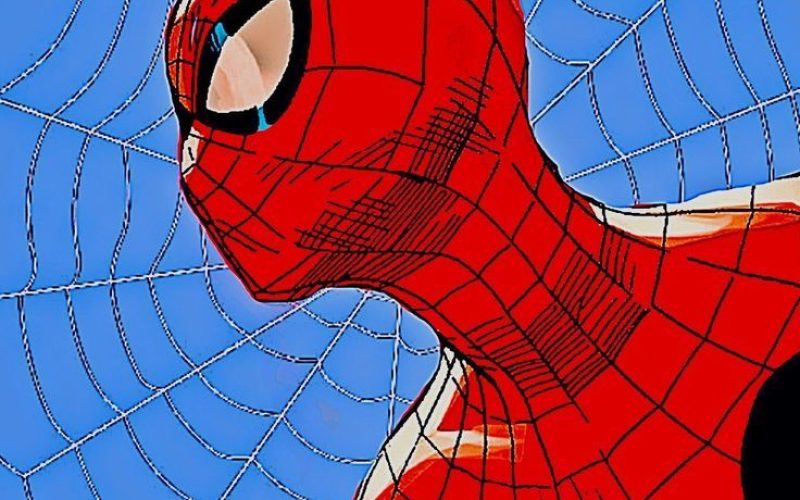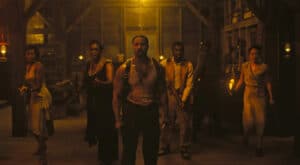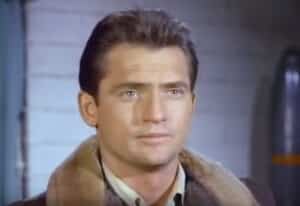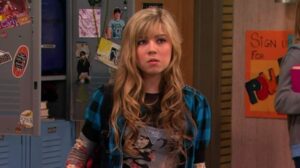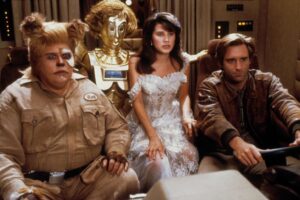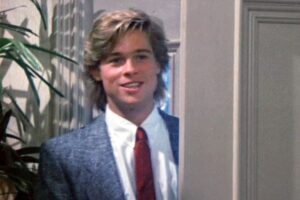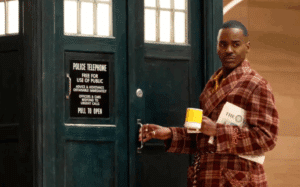Spider-Man is one of the most iconic superheroes of all time—but he didn’t start out that way. When Marvel Comics introduced him in Amazing Fantasy #15 back in 1962, no one expected a skinny teenager in red-and-blue tights to change the game. Since then, Spider-Man has become a global phenomenon, starring in countless comic runs, hit movies, TV shows, video games, and more. This is the full breakdown—from his humble origins to his current multiverse-spanning legacy.
The Birth of Spider-Man: From Reject to Icon
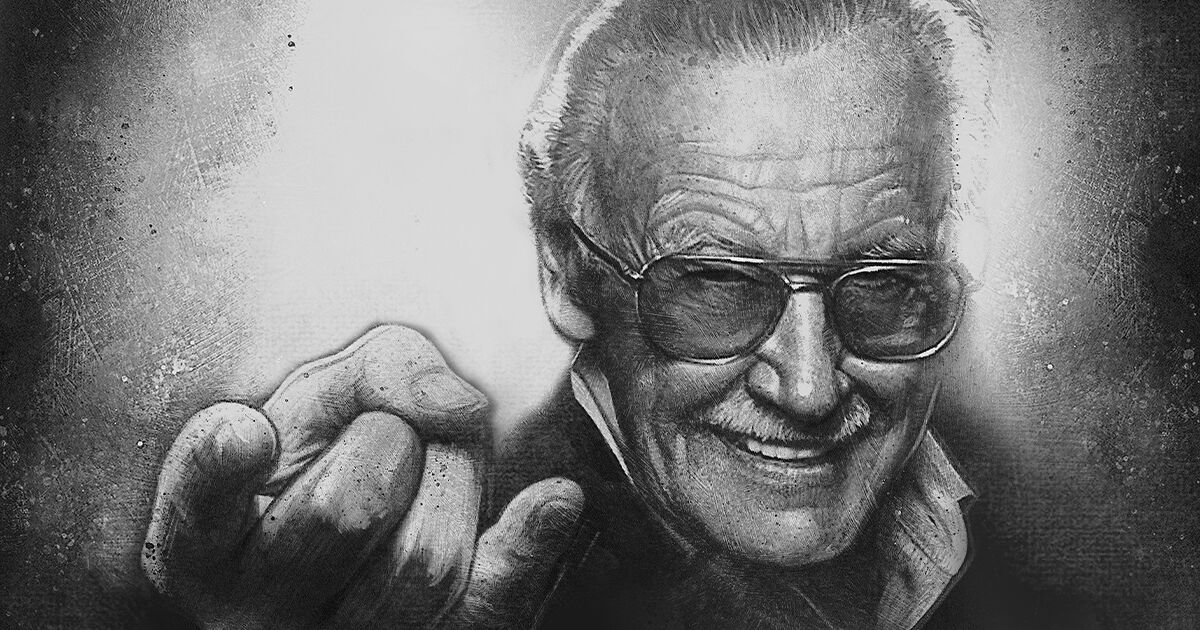
Before he became one of the most beloved superheroes on the planet, Spider-Man was just a weird little idea that nobody at Marvel really believed in—except one man: Stan Lee.
It was the early 1960s, and superheroes were making a comeback. Marvel had already struck gold with The Fantastic Four, and Stan Lee was on a roll, co-creating bold new characters like the Hulk, Thor, and Iron Man. But despite the momentum, Stan was getting restless. He wanted to try something different—something a little more human, a little more grounded.
Then, as the story goes, inspiration struck in the most unexpected way.
“I went home and I saw a fly crawling on the wall,” Stan later recalled. “And I said, hey, if I could get a superhero that could stick to walls and crawl on them… man, that would be cool.”
From that simple observation, the core of Spider-Man was born. A character who could cling to walls, swing through the city, and strike from the shadows. Not just another cape-wearing powerhouse, but something different—quirkier, creepier, and strangely compelling. But the concept still needed a name, and Stan went through a few… unusual options.
“So let’s see… Fly-Man? Mosquito-Man?” he joked years later. “I got down to Spider-Man. Spider-Man—it just sounded dramatic.”
That name changed everything. “Spider-Man” felt bold and edgy, even slightly unsettling—which was perfect. The powers, the name, and the vibe were all there. But then Stan took it one step further. He decided this hero wouldn’t be a flawless adult savior like Superman or Captain America. He’d be a teenager. A kid with real-life problems. Insecure, broke, awkward, and overwhelmed.
“I’m going to give him personal problems,” Stan said. “Then I thought I’d make him a teenager—because there were no teenage superheroes that I knew of at the time.”
That detail changed the entire formula. Superheroes, up until that point, weren’t supposed to be like this. They didn’t get bullied. They didn’t have acne. They didn’t worry about rent or rejection or not fitting in. But Peter Parker would. Stan leaned into those flaws and made them part of the character’s DNA.
When he pitched the idea to his boss, publisher Martin Goodman, the reaction was swift and brutal.
“Stan, that is the worst idea I have ever heard,” Stan remembered him saying. “People hate spiders, so you can’t call a hero Spider-Man. You want him to be a teenager? Teenagers can only be sidekicks. And you want him to have personal problems? Stan, don’t you know what a superhero is? They don’t have personal problems.”
It was a flat-out no. But Stan didn’t let it go.
As fate would have it, Marvel was about to shut down an anthology series called Amazing Fantasy. Since the book was getting canned anyway, Stan figured he had nothing to lose. He slipped Spider-Man into the final issue—Amazing Fantasy #15, published in August 1962—and put him right on the cover.
Just like that, Spider-Man’s origin was out in the world. A 15-page story told the tale of Peter Parker: a brainy, awkward high school student who gains superpowers after being bitten by a radioactive spider. At first, Peter tries to cash in on his powers as a TV star, only to watch helplessly as his selfishness leads to the death of his beloved Uncle Ben—a death he could have prevented. That moment hit readers like a gut punch.
Instead of a noble hero who chose justice, Spider-Man was a kid who failed—and then learned the hard way what it meant to take responsibility.
When the sales numbers came back a month later, they were huge. Amazing Fantasy #15 had outsold expectations.
“My publisher came racing into my office,” Stan said. “‘Stan, you remember that character we both loved so much—Spider-Man? Let’s do him as a series!’”
That series became The Amazing Spider-Man, which launched in March 1963. With it came the introduction of Aunt May, J. Jonah Jameson, Flash Thompson, Betty Brant, and a growing list of villains who would become legendary: the Vulture, the Lizard, Doctor Octopus, and the Green Goblin. Steve Ditko’s sharp, unsettling art style gave Spider-Man a wiry, unique look that stood out from Marvel’s other heroes. He didn’t look strong or invincible—he looked like a skinny kid trying to hold everything together. And that’s what readers loved.
Spider-Man was a superhero, sure. But he still had to worry about getting home in time for dinner or failing a science quiz. His life didn’t get easier when he put on the mask—it got harder.
For Stan, the success of Spider-Man wasn’t just a creative win. It was a personal one. “If you have an idea that you genuinely think is good, don’t let some idiot talk you out of it,” he once said in a now-famous speech. “You can only do your best work if you’re doing what you want to do. And if you can take pride in it after you’ve done it… no matter what it is… you can look at it and say, ‘I did that. And I think it’s pretty damn good.’ That’s a great feeling.”
Spider-Man was that idea for Stan. The one everyone said wouldn’t work. The one he couldn’t let go of.
And decades later, millions of readers, viewers, and fans around the world are still glad he didn’t.
Swinging Through the Decades: Spider-Man Comics Timeline
Spider-Man’s been slinging webs since the early ’60s, and his comic book history is about as packed as his backpack during midterms. Over the decades, the character has evolved with the times—sometimes painfully so—and his stories have mirrored everything from teen angst and tragedy to identity crises, alien goo, and full-blown existential drama. Here’s how Spider-Man grew up on the page, one decade at a time.
🕸️1960s – The Neighborhood Hero🕸️
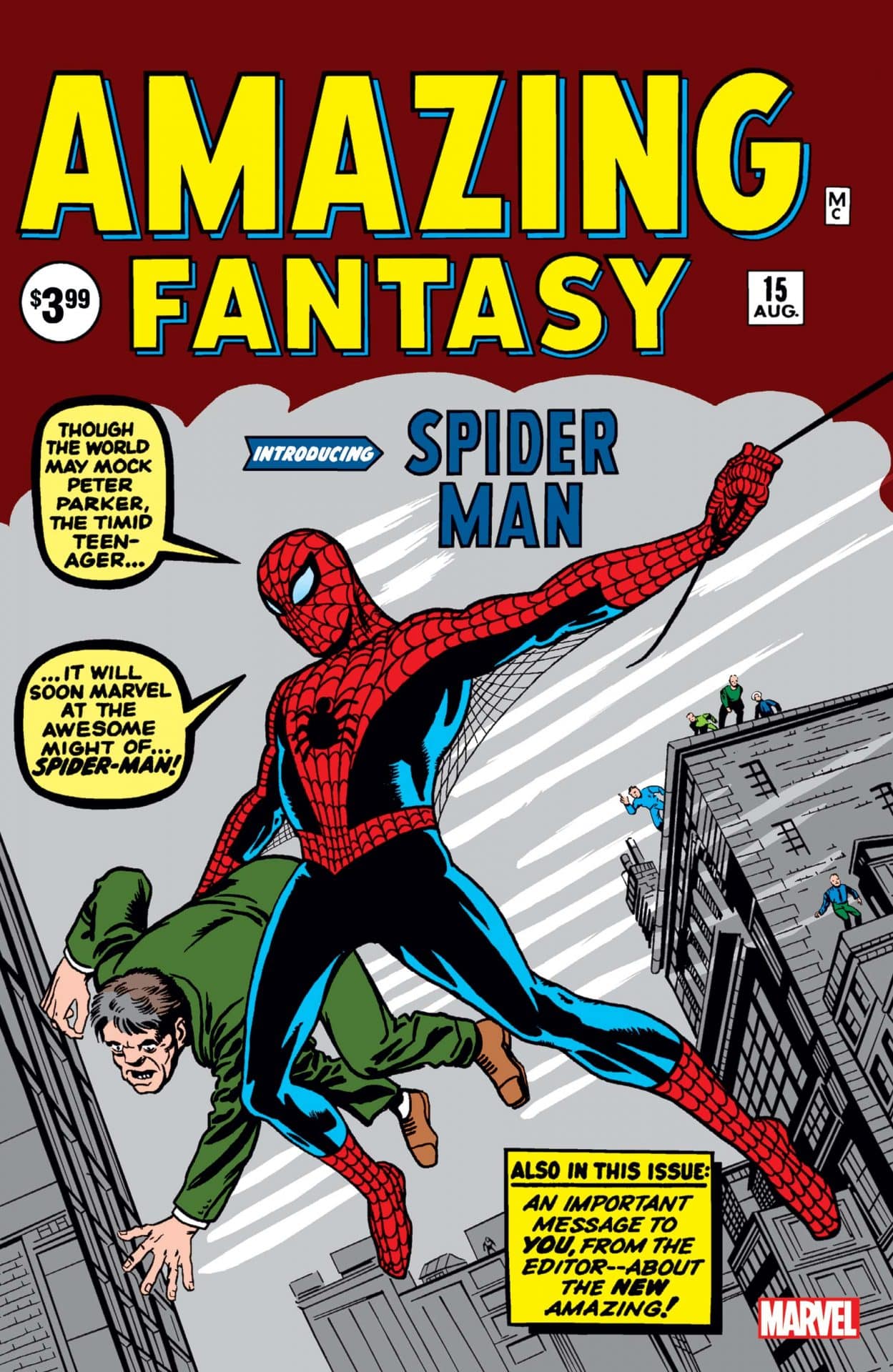
Spider-Man officially launched with The Amazing Spider-Man #1 in 1963, just a few months after debuting in Amazing Fantasy #15. Right out of the gate, Peter Parker stood apart from the crowd. He wasn’t a billionaire, a god, or a super-soldier—just a brainy, broke teenager in Queens trying to figure life out after getting bitten by a radioactive spider.
Stan Lee and Steve Ditko made Peter feel real. He had zits, homework, and anxiety. But when he put on that mask, he became something bigger—and that tension between responsibility and freedom became the core of the character.
The early run wasted no time building out a Hall of Fame-level rogues’ gallery. We’re talking Doctor Octopus, the Vulture, the Lizard, Sandman, Mysterio, and the Green Goblin—all introduced within the first few years. These weren’t just punching bags either; most had tragic backstories or personal ties to Peter’s life, which added extra weight to every fight.
Peter’s love life started to get messy around this time, too. Gwen Stacy was introduced in issue #31, followed by Mary Jane Watson in issue #42—complete with that unforgettable “Face it, Tiger…” panel. MJ was pure confidence and chaos, while Gwen brought a quieter, more grounded energy. The love triangle became a defining part of Peter’s world.
By 1966, Steve Ditko left the book, reportedly after creative clashes with Stan Lee. John Romita Sr. took over, and his art brought a more polished, romantic style to the book. Under Romita’s pencil, Peter started to grow up. He got more confident, his circle of friends expanded, and the emotional stakes of the stories started to hit harder. The early Ditko years were weird and raw, but Romita helped mold Spider-Man into Marvel’s flagship coming-of-age saga.
🕸️1970s – Realism, Drugs, and Death🕸️
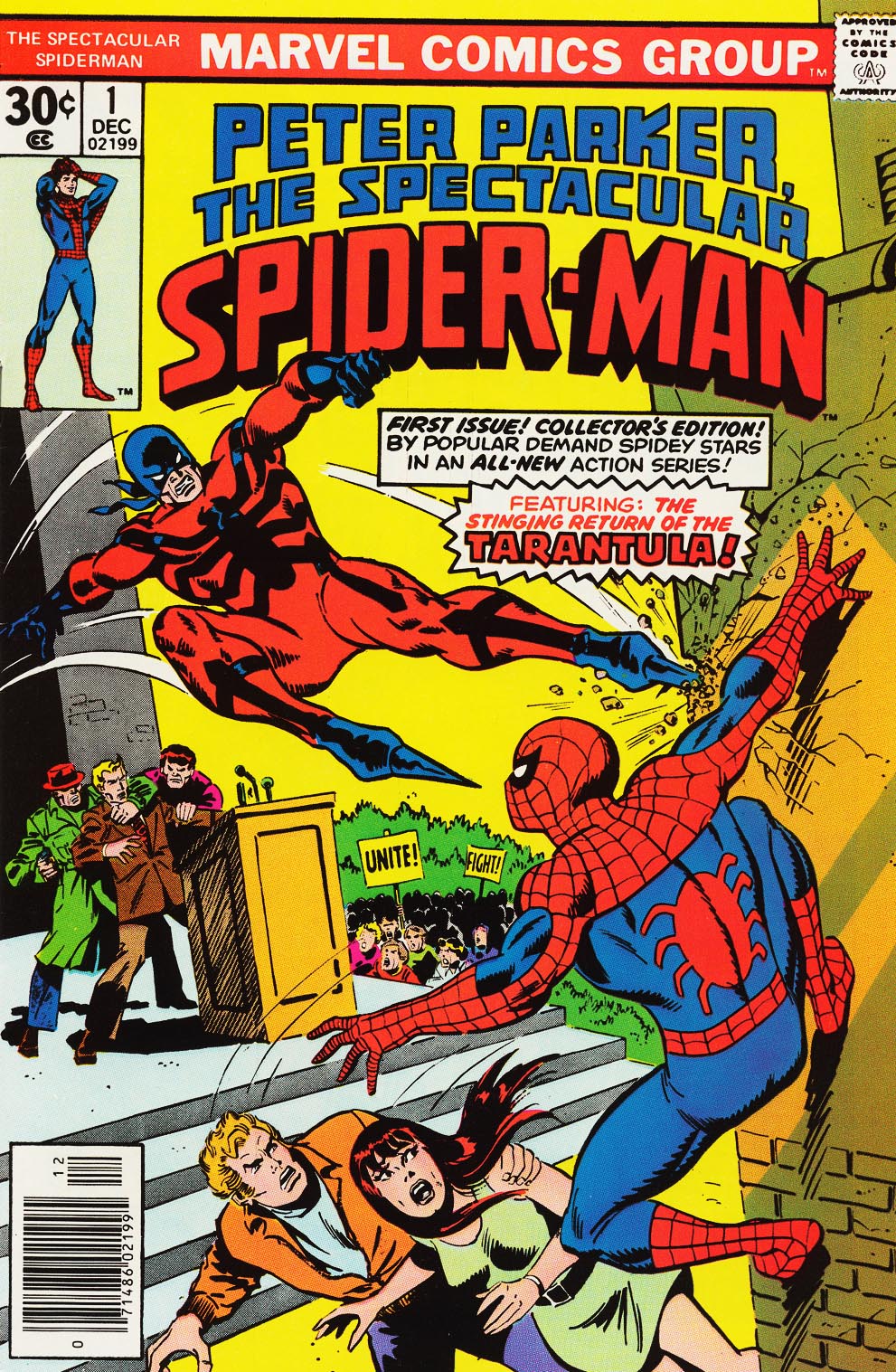
The ’70s didn’t pull punches. This was the decade where Spider-Man comics got heavy—and not just with the action.
In 1971, Marvel made headlines by publishing The Amazing Spider-Man issues #96–98 without the Comics Code seal. Why? Because the story tackled drug abuse head-on—Harry Osborn gets hooked on pills, spiraling into a dangerous mental health crisis. The Code didn’t allow drug depictions, even to condemn them, but Stan Lee pushed ahead. The issues sold well, were praised for their honesty, and helped force the Comics Code to change its outdated rules.
Then came The Night Gwen Stacy Died. If you know, you know. In issues #121–122, the Green Goblin kidnaps Gwen and tosses her off a bridge. Peter tries to save her with his web—but it snaps her neck. It was brutal, sudden, and real. For many fans, it was the moment superhero comics grew up. Gwen’s death changed Peter forever—and it set the tone for a decade of darker, more grounded storytelling.
Harry Osborn’s descent into addiction and madness added to the emotional weight. He eventually took up his father’s mantle as the second Green Goblin, turning one of Peter’s oldest friends into a dangerous wildcard.
The ’70s also introduced some weirdness that would come back in a big way later: the Jackal and the earliest clone storylines. The Jackal, aka Miles Warren, was a biology professor obsessed with Gwen Stacy who started experimenting with cloning after her death. It didn’t blow up immediately—but it laid the groundwork for the massive Clone Saga of the ’90s.
And speaking of major debuts: The Amazing Spider-Man #129 (1974) gave us the Punisher. Initially a gun-toting villain hunting Spidey, Frank Castle’s no-nonsense brand of justice made him an instant fan favorite—and eventually a star in his own right.
On the lighter side, Marvel teamed up with PBS’s The Electric Company to create Spidey Super Stories, a kid-friendly comic series that ran from 1974 to 1982. These issues featured simplified plots and big, bold art, making them perfect for younger readers. They also tied into live-action Spider-Man shorts that aired during The Electric Company, introducing a whole generation of kids to Spidey in five-minute chunks.
🕸️1980s – Symbiotes and Weddings🕸️
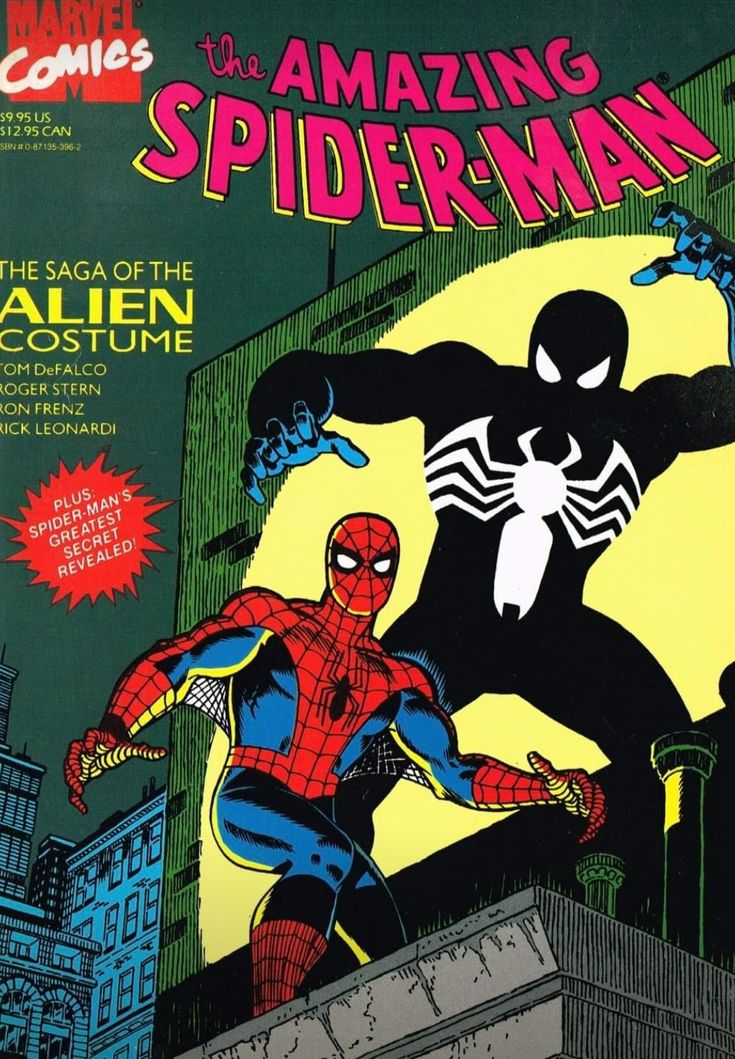
If the ’70s were about loss and trauma, the ’80s were about transformation. Spider-Man’s world got bigger, bolder, and honestly, a little weirder. This was the decade where we saw one of his most iconic costume changes, his darkest psychological battle, and—believe it or not—a full-blown wedding.
Let’s start with the suit. In 1984’s Secret Wars, Marvel’s first big company-wide crossover event, Spider-Man shows up to battle on an alien planet alongside heroes like the X-Men and the Avengers. When his classic costume gets shredded in the chaos, he stumbles upon a mysterious black glob that reshapes itself into a sleek, all-black suit with a white spider symbol. At first, it’s slick. He can control it with his mind. It never tears. It makes him stronger. Too good to be true, right? Right.
Eventually, Peter realizes the suit is alive—literally. It’s a symbiote that’s trying to permanently bond with him. He ditches it (in Web of Spider-Man #1, no less), and it finds a new host in Eddie Brock, a disgraced journalist with a serious vendetta. The result? Venom, introduced in Amazing Spider-Man #300 (1988). Hulking, grotesque, and every bit as agile as Peter, Venom quickly became one of Spidey’s most dangerous and popular foes.
But the ’80s weren’t just about new threats—they were also about psychological depth. Kraven’s Last Hunt (1987) pushed superhero comics into uncharted territory. In it, Kraven the Hunter finally defeats Spider-Man—by shooting him, burying him alive, and then impersonating him to prove he could be the “better” Spider-Man. It’s moody, grim, and weirdly poetic. Kraven, satisfied with his “victory,” kills himself. The story remains one of the most acclaimed arcs in Spidey history.
On the brighter side (well, kind of), Peter and Mary Jane tied the knot in The Amazing Spider-Man Annual #21. It was a big deal—not just in the comics, but in real life too. Marvel even held a live wedding ceremony at Shea Stadium with actors in costume. For better or worse, the marriage would shape Peter’s story for the next two decades. Some fans loved seeing Spidey settle down. Others felt it aged the character too quickly. Either way, it was a major milestone.
Meanwhile, the art style was evolving fast. Enter Todd McFarlane. His ultra-detailed, hyper-stylized take on Spidey—complete with spaghetti-webbing and exaggerated poses—became the look of late-’80s Spider-Man. McFarlane’s influence was so massive that Marvel launched a new solo title, Spider-Man, in 1990 with him on both writing and art duties. It debuted to record-shattering sales and kicked off the “rock star artist” era of Marvel.
Throughout the decade, Spider-Man’s adventures spanned multiple series: The Amazing Spider-Man remained the flagship, but Web of Spider-Man and Peter Parker, the Spectacular Spider-Man added depth, explored B-plots, and gave space to side characters like the Black Cat.
And while it technically started in the ’70s, The Electric Company’s live-action Spider-Man shorts—where Spidey never speaks and communicates via thought bubbles—aired through the early ’80s and introduced an entire generation of kids to the character. It was silly, yes, but wildly influential.
🕸️1990s – Clones, Carnage, and Crossovers 🕸️
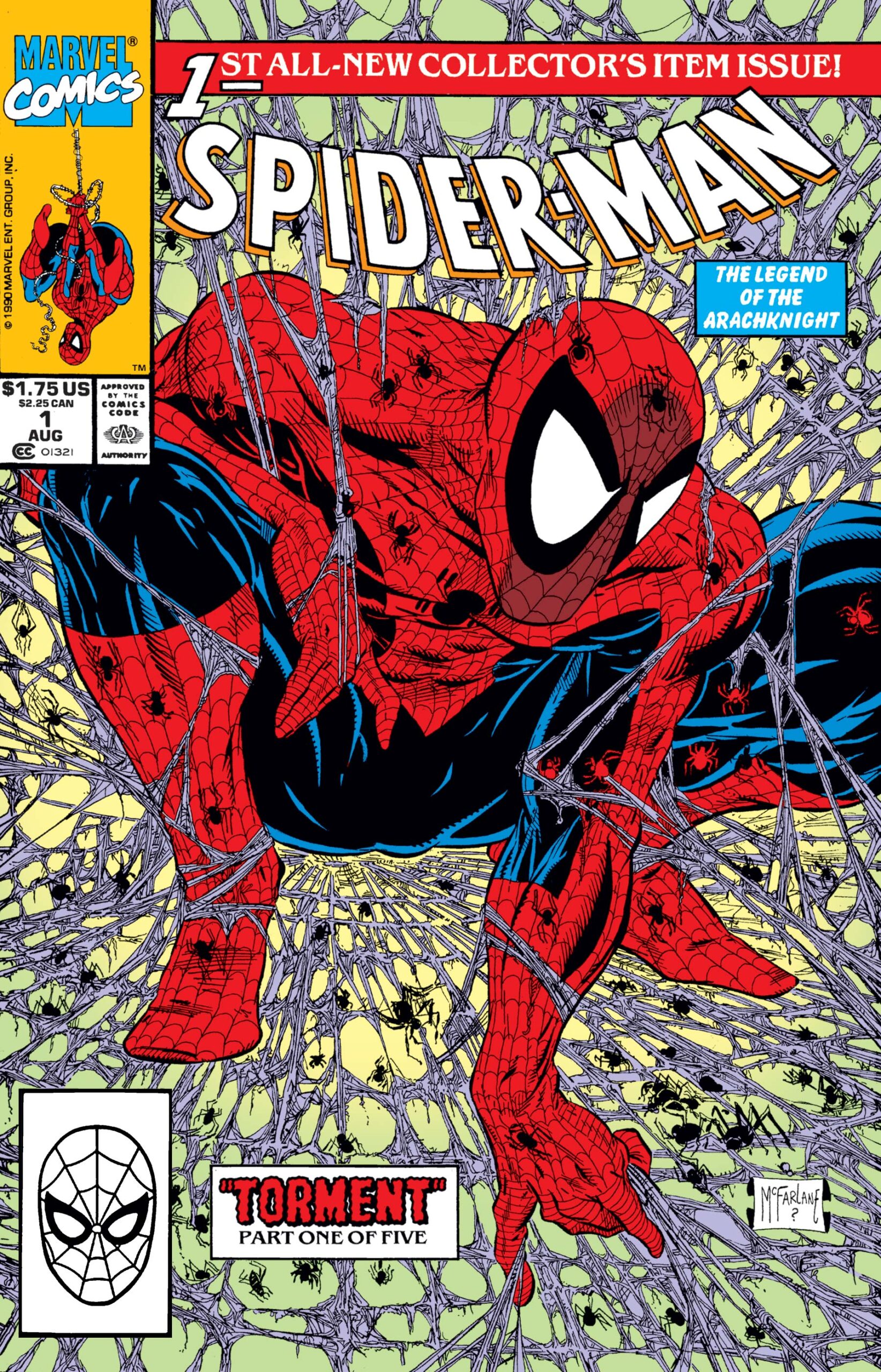
Ah, the ’90s. If the ’80s were stylish and intense, the ’90s cranked everything up to eleven—more action, more edge, more Spider-Men. This era was defined by clones, symbiotes, oversized guns, and foil comic covers. And somehow, through all the chaos, Spider-Man remained at the center of Marvel’s universe.
Let’s kick things off with Maximum Carnage (1993–1994). This 14-part crossover event brought together Spider-Man, Venom, and basically every street-level Marvel hero you can name to stop Cletus Kasady—a serial killer bonded with his own symbiote, Carnage—from unleashing total anarchy on New York City. It was loud, violent, and VERY ’90s. The event also inspired a beloved SNES/Genesis video game, which cemented Carnage’s status as the edgelord icon of the decade.
But nothing defined ’90s Spider-Man like the Clone Saga. Initially a throwback to a brief 1970s storyline involving Peter’s clone, Ben Reilly, this saga exploded into a sprawling epic that lasted over two years across every Spider-title. At one point, Marvel even suggested that Ben—now fighting crime as the Scarlet Spider—was the real Peter Parker all along. Fans were not thrilled. It was convoluted, confusing, and never seemed to end. Still, Ben Reilly developed a cult following, and his red hoodie costume remains a fan favorite to this day.
The decade also gave us Spider-Man 2099—a future-set series starring Miguel O’Hara, a geneticist living in the cyberpunk world of Nueva York. Launched in 1992, this version of Spider-Man had a sleek blue-and-red suit, claws, and no internal monologue boxes (instead using dialogue and holograms). Miguel became one of the few new heroes from that era to actually stick around and thrive in later years—especially in today’s multiverse-driven stories.
Spider-Man Unlimited, launched in 1993 as a comic and again in 1999 as an animated show, took Spidey into bizarre, sci-fi territory. The comic featured backup stories and experimental arcs, while the cartoon sent Peter to “Counter-Earth,” a planet ruled by animal hybrids. It only lasted 13 episodes, but it definitely left an impression.
As for crossovers? The ’90s were packed. Spider-Man was front and center during events like Infinity Gauntlet, Onslaught, and Secret Invasion—even if he didn’t always have the biggest role. Then there was Marvel vs. DC (1996), the wild one-time crossover where Spider-Man went head-to-head with Superboy. Fans voted on the outcomes of battles, and Spidey came out on top. No surprise there.
The ’90s were chaotic, and not every story stuck the landing. But there’s no denying the era was ambitious. Spider-Man wasn’t just reacting to the Marvel Universe—he was helping define it.
🕸️2000s – The Ultimate Reinvention 🕸️

By the time the 2000s rolled around, Spider-Man was in serious need of a refresh. The ’90s had left the character a little overexposed—with too many clones, too many crossovers, and too many titles to keep track of. Marvel responded with a bold idea: start over. Sort of.
That idea took shape in Ultimate Spider-Man, which launched in 2000 as the flagship title of Marvel’s new “Ultimate” line—a fresh continuity aimed at younger readers and newcomers. Written by Brian Michael Bendis and drawn by Mark Bagley, Ultimate Spider-Man reimagined Peter Parker from scratch: same core origin (radioactive spider, dead uncle, guilt trip), but with modern pacing and updated dialogue. And it worked. The series was a massive hit, praised for its slow-burn storytelling and believable teen drama. Peter didn’t even put on the suit until the end of the first issue. It was all character-first, and it proved you didn’t need to reinvent Spider-Man—you just needed to reintroduce him.
Back in the mainline continuity, though, things were getting complicated.
In 2006, Civil War rocked the Marvel Universe—and Spider-Man was at the heart of it. The premise: superheroes are divided over a new law that forces them to register their identities with the government. Tony Stark was pro-registration. Captain America was against it. Peter Parker? Torn in the middle. At first, he sides with Iron Man, even going so far as to publicly reveal his identity to the world. “My name is Peter Parker, and I’ve been Spider-Man since I was fifteen years old.” It was a huge moment—arguably the biggest shock in Spider-Man comics in decades.
The fallout, of course, was brutal. Villains now knew who he was. Aunt May got shot by a sniper. And Peter’s entire life unraveled. To undo the damage, Marvel took a swing that’s still controversial to this day: One More Day.
That 2007 arc saw Peter make a literal deal with the devil—Mephisto—to save Aunt May’s life in exchange for erasing his marriage to Mary Jane from existence. Just like that, decades of continuity were wiped. Peter and MJ had never tied the knot. Their relationship? Reset to a vague “it’s complicated.” Fans were divided. Some were furious. Others understood the move: Marvel wanted a younger, single Peter again, closer in tone to the original ’60s-era stories. Either way, the decision changed Spider-Man’s status quo for years.
Out of that reset came Brand New Day (2008), a relaunch of the core titles with a rotating team of writers and artists. Peter was back to living in a crappy apartment, broke, unlucky in love, and just trying to get by. Villains like Mister Negative and Menace were introduced, and the tone leaned lighter—more fast-paced, more fun. It wasn’t perfect, but it felt like a new start.
Also worth mentioning: The Other (2005–2006), a strange, moody crossover event that played with mysticism and body horror. The story had Peter dying (sort of), cocooning himself, and coming back to life with enhanced powers—including organic webbing and bone stingers. It was divisive, to say the least, but it added a supernatural layer to Spidey’s origin that Marvel would revisit off and on in later years.
The 2000s also saw a steady evolution in Spider-Man’s supporting cast and art style. With creators like J. Michael Straczynski and John Romita Jr. taking the reins on Amazing Spider-Man, the series often took a more philosophical tone. Straczynski explored Peter’s ties to something called the “Spider-Totem”—hinting that Peter’s powers might not have been an accident after all. It was a wild, metaphysical direction that some fans loved, and others never fully bought into.
Still, for all the twists and resets, the 2000s were about keeping Spider-Man relevant. Whether it was through the modernized storytelling of Ultimate Spider-Man, the headline-grabbing unmasking in Civil War, or the controversial retcon in One More Day, Marvel was clearly trying to figure out how to balance decades of continuity with a character who’s supposed to stay forever young.
🕸️2010s – The Multiverse and Legacy🕸️
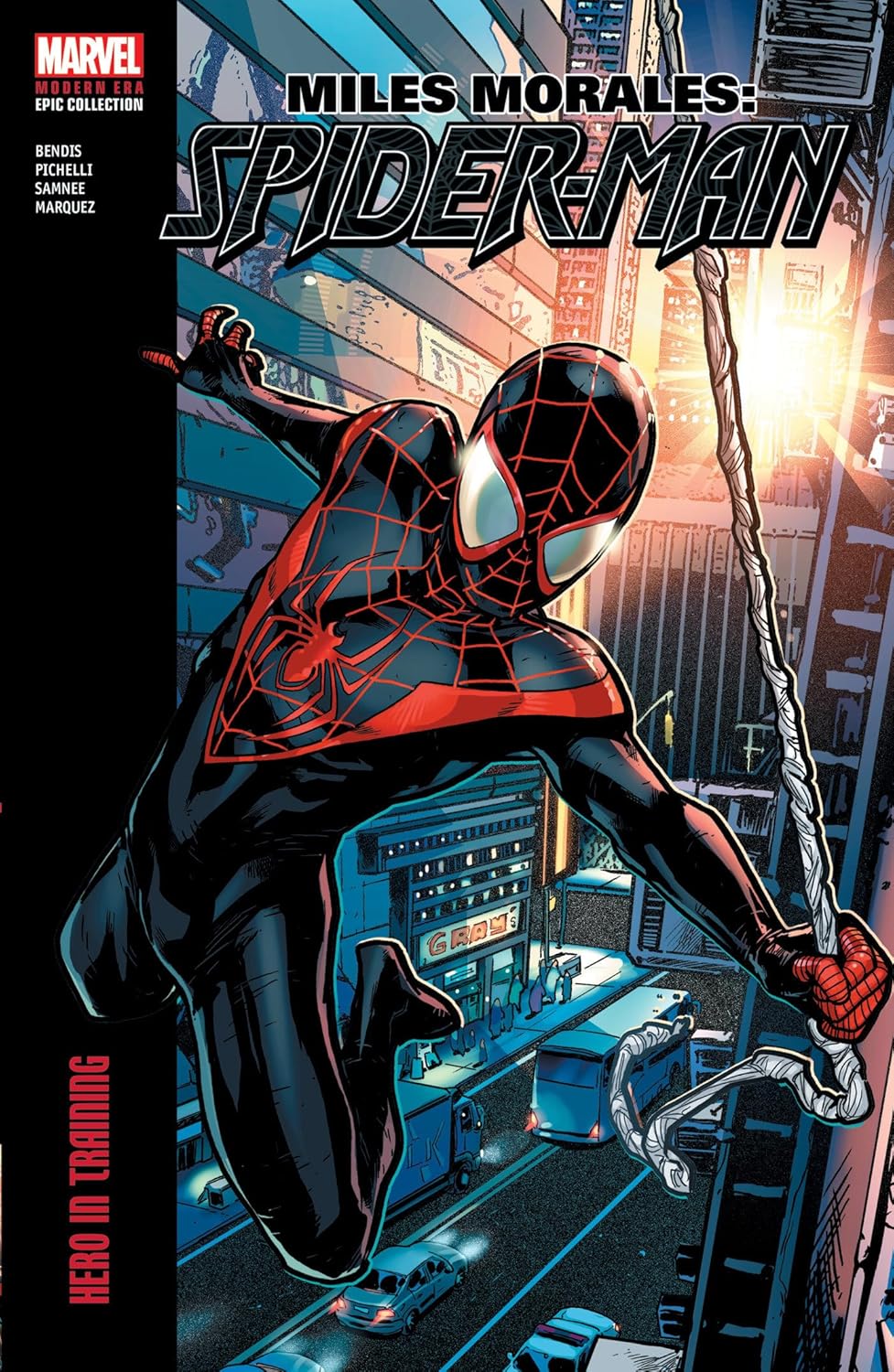
The 2010s were a turning point—not just for Peter Parker, but for the entire Spider brand. This was the decade where “Spider-Man” officially stopped being a single identity and became a multiversal legacy. It was bold, weird, often controversial—but it worked.
The biggest swing came in 2013 with Superior Spider-Man. After years of being one of Peter’s most dangerous enemies, Doctor Octopus pulled the ultimate move: he won. In Amazing Spider-Man #700, Otto Octavius swapped minds with a dying Peter Parker, leaving Peter’s consciousness trapped in his own failing body. Otto inherited Peter’s body, powers, and memories—and surprisingly, decided to become a better Spider-Man than Peter ever was. Hence the name: Superior Spider-Man.
It was a gutsy move by writer Dan Slott, and fans were understandably skeptical at first. But over 30+ issues, the story evolved into something layered and fascinating. Otto was arrogant, calculating, even brutal—but he cared. He started his own tech company. He got a doctorate. He fell in love. And in the end, when faced with a threat he couldn’t beat, he gave the body back to Peter. Not because he was defeated—but because he realized Peter was, in fact, the better man.
Peter returned in 2014, and from there, things escalated quickly—especially in the multiverse department.
That same year, Marvel launched Edge of Spider-Verse, which introduced readers to alternate Spider-characters from across the multiverse. Some had been seen before (Spider-Man 2099, Spider-Ham), but others were brand new:
-
Silk (Cindy Moon), a classmate of Peter’s bitten by the same spider
-
Spider-Gwen (Gwen Stacy from an alternate universe where she got the powers)
-
Spider-Punk (Hobart Brown, an anarchist rocker from a dystopian Britain)
-
Spider-UK, Spider-Man India, and tons more
These characters came together in Spider-Verse (2014–2015), a crossover event that pitted an army of multiversal Spideys against the Inheritors—a vampiric family hunting Spider-Totems across realities. It was chaotic, fun, and incredibly fan-servicey in the best way. Spider-Gwen, in particular, became an instant hit, launching her own solo series with a punk-rock aesthetic and one of the most cosplayable costumes ever.
Later, Spider-Geddon (2018) served as a kind of sequel to Spider-Verse, bringing many of the same characters back for another dimension-hopping clash, though it didn’t land with quite the same punch as the first event.
And then there’s Miles Morales. While he’d debuted in 2011 in Marvel’s Ultimate universe (after the death of Ultimate Peter Parker), the 2010s saw Miles officially join the mainline Marvel continuity. Thanks to the 2015 Secret Wars reboot, Miles and his supporting cast were folded into Earth-616, giving Marvel two Spider-Men in the same universe—and readers couldn’t have been happier. Miles brought fresh energy, a new cultural voice, and a different kind of story to the Spider-family. And unlike most “legacy” heroes, he didn’t feel like a replacement—he was his own thing, and fans embraced it.
By the end of the 2010s, Spider-Man wasn’t just a character—it was a franchise within the Marvel Universe. Dozens of spider-heroes, multiple timelines, and a growing fanbase that wasn’t just along for the ride—they were steering it.
🕸️2020s – Reboots and Modern Spider-Heroes🕸️
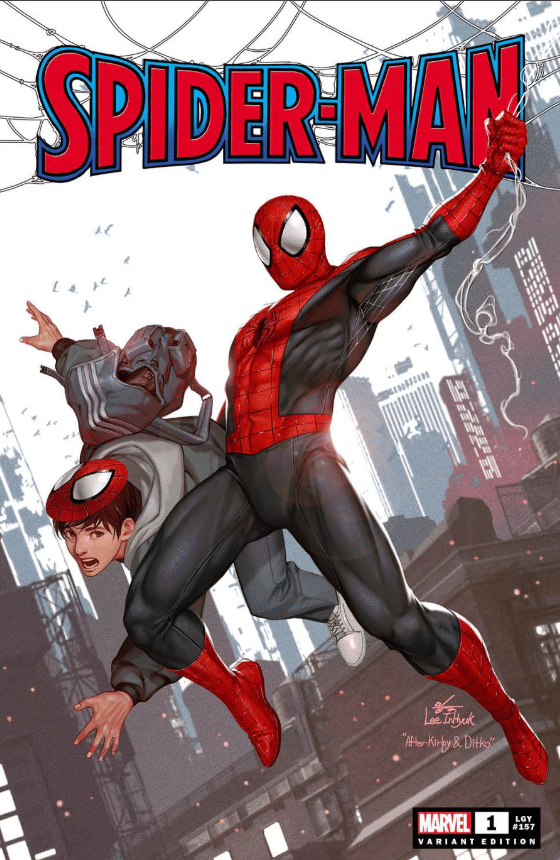
The 2020s are still unfolding, but if there’s one word to sum up the decade so far for Spider-Man comics, it’s chaotic—in the best and worst ways. Marvel’s been trying to keep things fresh, bouncing between legacy, experimentation, and big status quo shifts. Not every arc has landed clean, but the web’s definitely still spinning.
The biggest reset early in the decade was Beyond (2021–2022), which took Peter Parker off the board temporarily and put Ben Reilly—yes, the clone—back in the Spider-suit. Backed by the mysterious Beyond Corporation, Ben took on a slick new costume and a corporate-style approach to crime fighting. It was a mix of satire, tragedy, and moral ambiguity. Eventually, things spiraled: Peter returned, and Ben, broken and manipulated, became Chasm, a darker, more unstable version of his former self. His turn set the stage for 2022’s Dark Web, a supernatural crossover event that teamed Chasm with Madelyne Pryor (the Goblin Queen) to unleash demonic chaos on New York.
Meanwhile, the mainline Amazing Spider-Man title relaunched (again) with Zeb Wells writing and John Romita Jr. on pencils. Their run has been polarizing. On one hand, it brought back classic elements—like Peter’s bad luck, street-level storytelling, and his on-again, off-again thing with MJ. On the other hand, it’s been criticized for vague storytelling (especially the “What did Peter do?” mystery box) and some divisive character turns. Still, it’s undeniably active. Every few issues feels like something big is about to go down—even if the payoff’s still coming.
And while Peter’s world has been a little unstable, the Spider-family around him continues to grow and thrive:
-
Kaine, the rogue clone turned anti-hero, continues to lurk on the fringes of Spidey lore
-
Jessica Drew (Spider-Woman) has had a major resurgence, including multiple solo series and crossovers
-
Mayday Parker (Spider-Girl) is back in the mix thanks to multiverse stories and fan nostalgia
-
Arana, aka Anya Corazon, has also returned to a more central role, especially in all-ages titles and team books like Spider-Verse and Edge of Spider-Geddon
This era has also been big on crossover events tied into the street-level Marvel world. The current arc, Gang War, sees Peter teaming up with Miles, Elektra, Luke Cage, and others to stop a violent citywide turf war. It’s grounded, brutal, and brings the focus back to Spidey’s roots—defending his neighborhood, one street at a time.
Where it all goes next? Hard to say. But if the last few years have proven anything, it’s that Spider-Man—and the world around him—isn’t slowing down anytime soon. There may be more spider-heroes than ever, but at the center of it all, Peter Parker’s still swinging.
Wall-Crawler on the Small Screen
Before he conquered movie theaters, Spider-Man was already a TV staple—slinging webs on Saturday mornings, dodging lasers in 2D animation, and even squaring off against crime in live-action spandex. Across decades and dozens of shows, the character has been reimagined, rebooted, and repackaged for every age group and screen size. Here’s a complete rundown of every animated and live-action Spider-Man series ever made.
🕸️Animated🕸️
Spider-Man (1967)
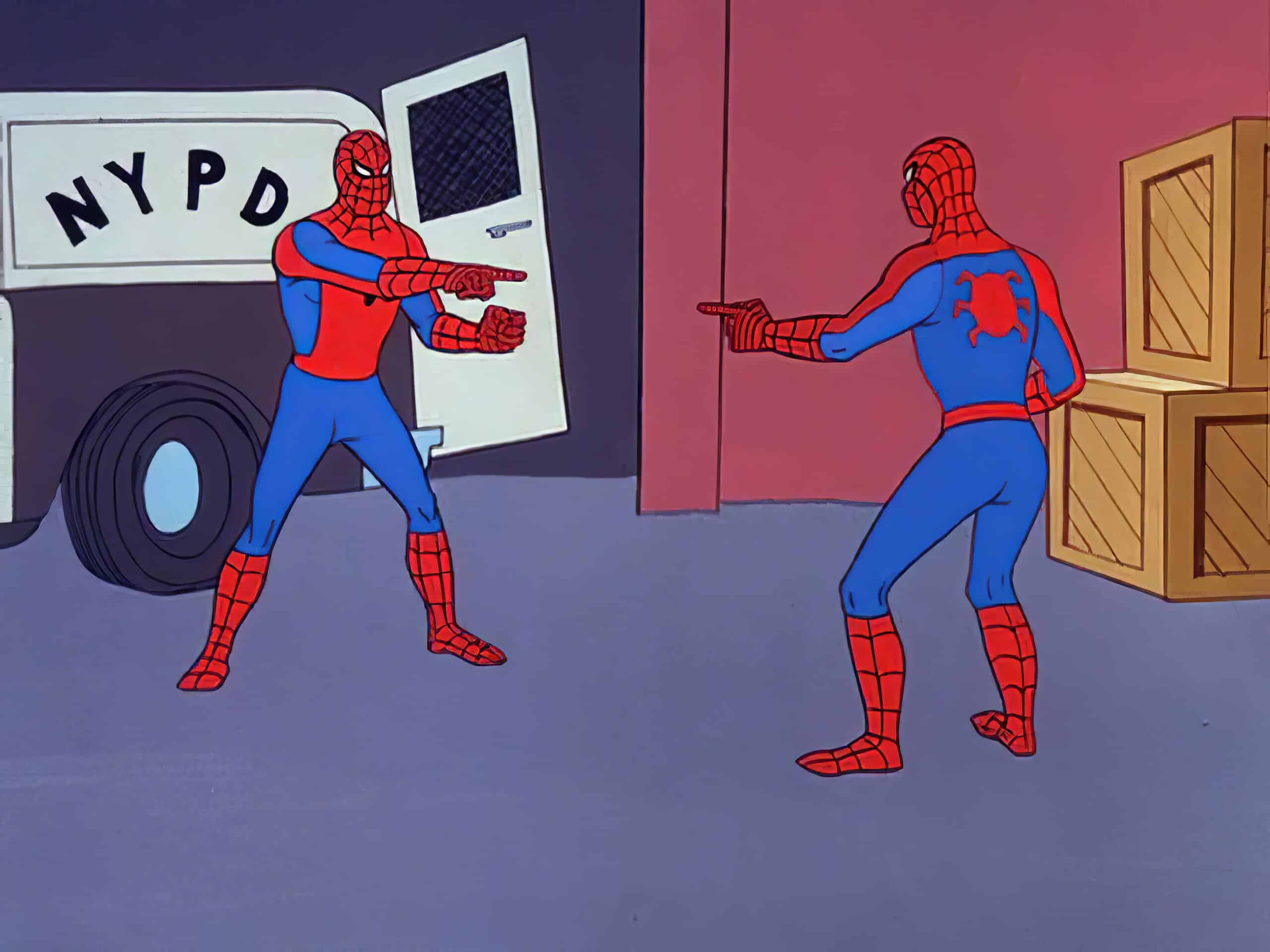
The one that started it all. This classic cartoon introduced millions of kids to the wall-crawler—and gave us that iconic theme song (“Spider-Man, Spider-Man, does whatever a spider can“). The animation was rough, the pacing slow, and the fight scenes minimal, but it had charm. Budget constraints meant lots of reused footage, psychedelic backgrounds, and extremely limited motion—but somehow, it worked. Even today, this version lives on in meme culture (yes, that pointing Spider-Man image comes from here).
Spider-Man and His Amazing Friends (1981–1983)

Spidey teamed up with Iceman and Firestar in this lighthearted, Saturday morning-style show that leaned into friendship, teamwork, and wacky villains. Peter Parker lived with his superhero roommates in a secret high-tech lair hidden behind a bookcase. It was pure ’80s camp, complete with corny sound effects and punchy one-liners, but it was also a hit with kids. Notably, this was one of the first shows to introduce more Marvel characters into the Spider-universe, including Captain America and the X-Men.
Spider-Man: The Animated Series (1994–1998)

Now we’re talking. For many fans, this is the definitive on-screen Spider-Man. Airing on Fox Kids, this series took Peter Parker seriously—blending serialized story arcs with a surprisingly mature tone. Over five seasons, it tackled big plots: Peter’s relationships with MJ and Felicia Hardy, the creation of Venom and Carnage, multiverse crossovers, and even adaptations of The Clone Saga and Secret Wars. The voice work (especially Christopher Daniel Barnes as Spidey) was pitch-perfect, and the show’s visual style—bold lines, moody shadows, and kinetic action—set a new bar for superhero animation. It ended on a cliffhanger, sure, but it remains a high point.
Spider-Man Unlimited (1999)

A spiritual sequel to the ’90s series, this short-lived follow-up sent Spider-Man to “Counter-Earth,” a planet ruled by human-animal hybrids called Beastials. Peter wears a nanotech suit, the villains are completely wild, and the tone veers sci-fi dystopian. It only ran for 13 episodes due to low ratings and network shake-ups, but it’s remembered for its ambition—and its bonkers concept.
The Spectacular Spider-Man (2008–2009)
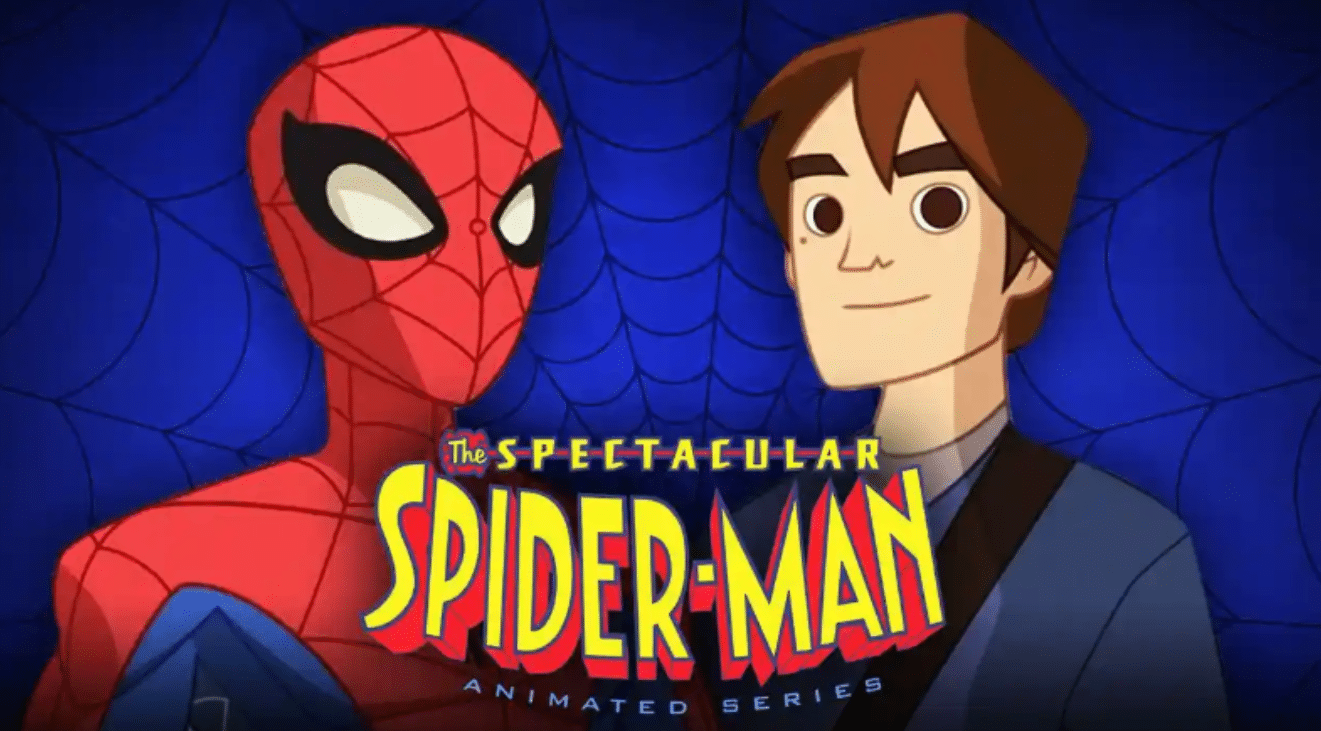
This one gets serious love from critics and fans. Created by Gargoyles alum Greg Weisman, The Spectacular Spider-Man combined sleek animation with tight writing and character development. It reimagined Peter’s early high school years while modernizing classic villains like Electro, Sandman, and Green Goblin. Every episode built toward something. Every character had an arc. Unfortunately, it was canceled after two seasons due to rights issues during the Disney–Marvel acquisition. But ask any fan? This show was spectacular in every way.
Ultimate Spider-Man (2012–2017)

With a more comedic, fourth-wall-breaking tone, Ultimate Spider-Man followed a younger, quippier Peter mentored by Nick Fury and SHIELD. The show leaned heavily into Marvel crossovers—Wolverine, Iron Man, Deadpool—and even introduced a proto-Spider-Verse with characters like Miles Morales, Spider-Gwen, and Spider-Ham. It wasn’t everyone’s favorite (some disliked the over-the-top humor), but it expanded the Spider-brand to a new generation and ran for four full seasons.
Marvel’s Spider-Man (2017–2020)
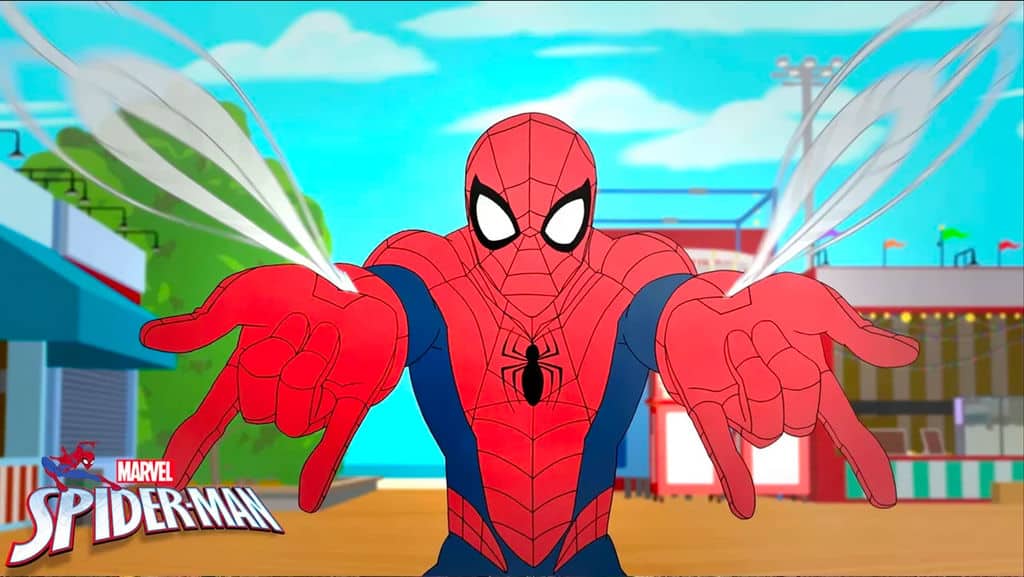
Replacing Ultimate, this version aimed for a more serialized, comic-accurate feel—but struggled with identity early on. The animation was clean but sometimes stiff, and the pacing was uneven. Still, it introduced popular arcs like Spider-Island and brought Miles Morales and Gwen Stacy into the main cast early. By Season 3 (Maximum Venom), the show found more confidence, with bigger stakes and stronger writing.
Spidey and His Amazing Friends (2021–present)
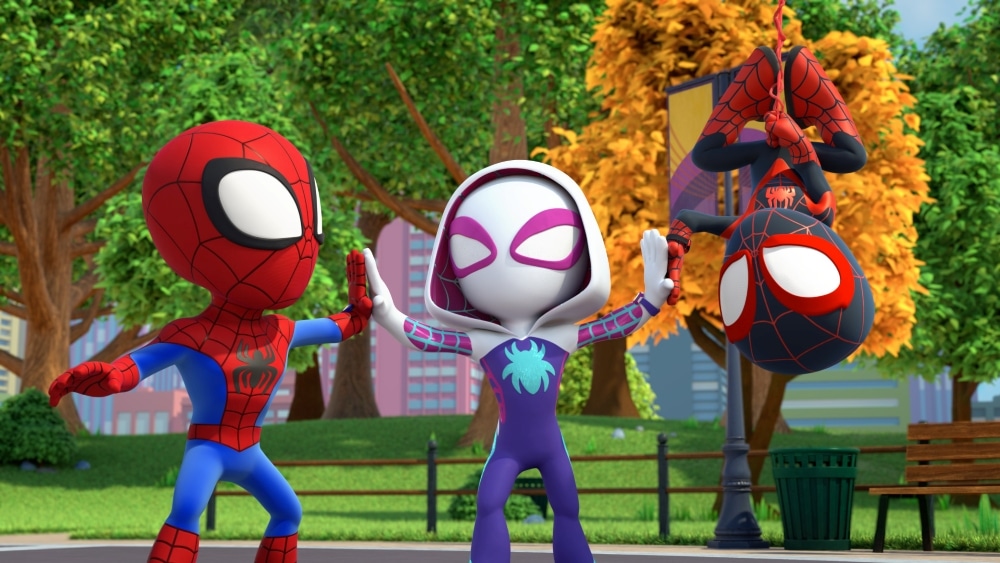
This is Spider-Man for the preschool crowd—and it works surprisingly well. Airing on Disney Junior, it stars Peter, Miles (“Spin”), and Gwen (“Ghost-Spider”) as a trio of tiny heroes solving problems with teamwork, gadgets, and good vibes. The animation is bright and simple, the villains are kid-friendly (Doc Ock is more mischievous than menacing), and the theme song slaps harder than it has any right to. It’s a hit with young kids and a great entry point for future fans.
🕸️Live-Action🕸️
The Amazing Spider-Man (1977–1979)

Starring Nicholas Hammond as Peter Parker, this live-action CBS series was Marvel’s first real attempt to bring Spider-Man to life on TV. It had a very TV-movie feel—low budget, simple plots, and villains that were mostly crooked businessmen or corrupt officials (no Goblins here). Still, Hammond had charm, and the show ran for 13 episodes and a couple of made-for-TV movies. It’s dated, sure—but weirdly watchable.
Spider-Man (Toei, 1978–1979)
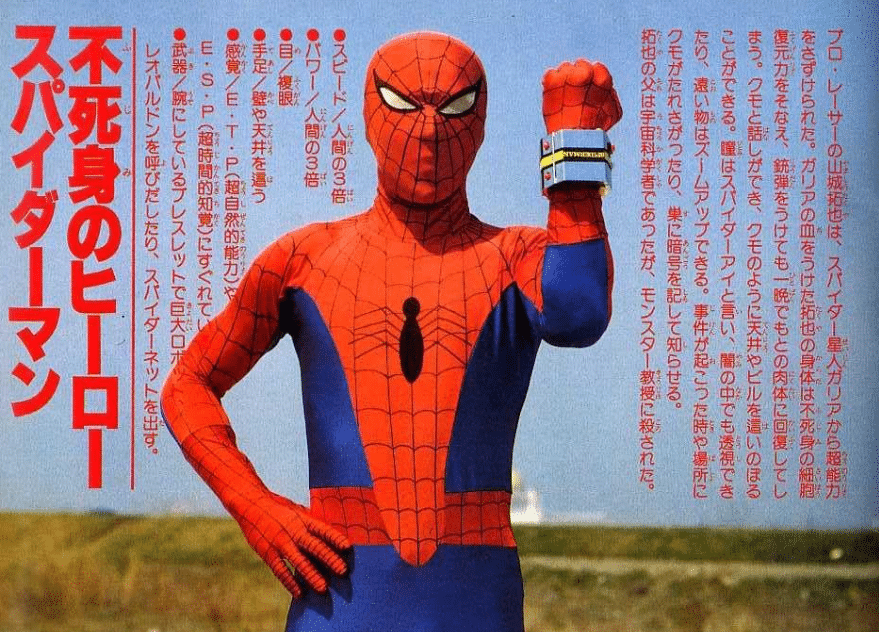
This is where things get wild. Produced by Japan’s Toei Company, this version of Spider-Man (a.k.a. Takuya Yamashiro) wasn’t Peter Parker, didn’t work for a newspaper, and absolutely did not get bitten by a radioactive spider. Instead, he piloted a giant robot (Leopardon) and fought rubber-suited monsters every week in classic tokusatsu style. It sounds bizarre—and it is—but this series was hugely influential. It inspired the creation of Super Sentai, which later became Power Rangers. Also? The suit still slaps.
The Electric Company Spider-Man (1974–1977)
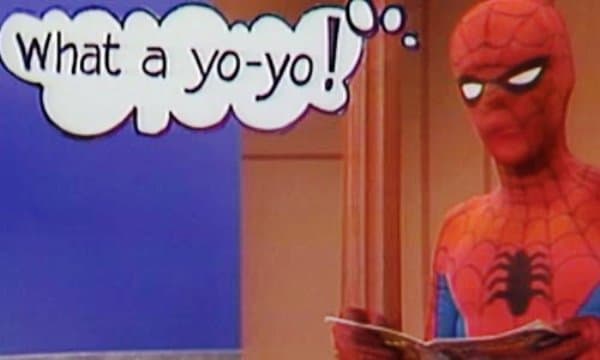
Appearing in short segments on the children’s PBS show The Electric Company, this live-action Spidey was silent, communicating only through on-screen word balloons. The bits were short, simple, and silly—but for an entire generation of ’70s kids, this was their first Spider-Man. Educational? Sort of. Iconic? Definitely.
James Cameron’s Unmade Spider-Man Movie (Early 1990s)
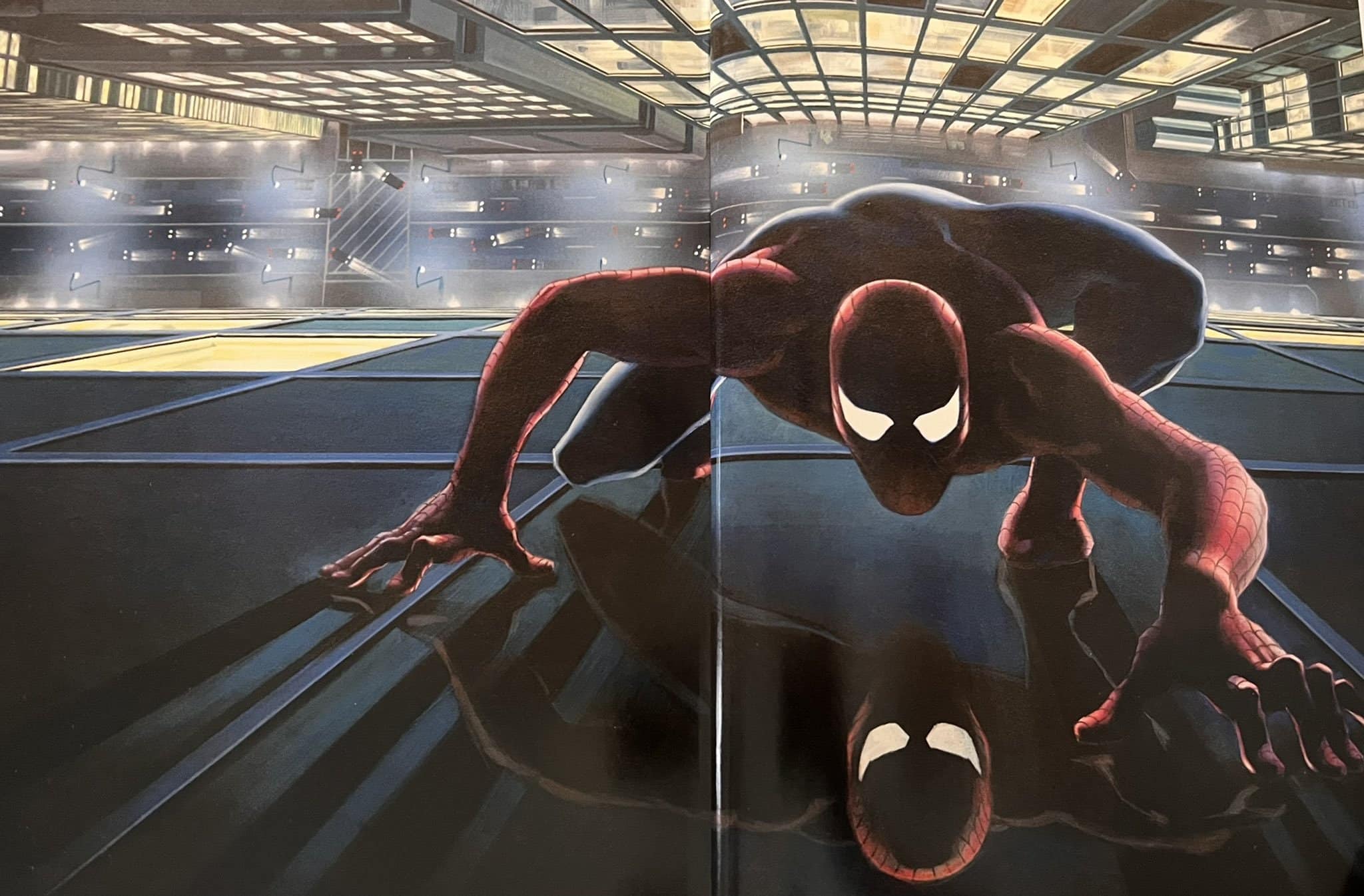
We almost got a very different Spider-Man in the ’90s—one written and directed by James Cameron. His script treatment included organic web-shooters (which Sam Raimi would later adopt), a darker tone, and R-rated dialogue. Electro and Sandman were the villains, though reimagined as corporate thugs. Leonardo DiCaprio was rumored to star. It never got made, thanks to a rights battle between studios—but the DNA of Cameron’s vision lives on in the Raimi trilogy.
Multiverse Cameos and MCU Appearances
By the time Spider-Man: No Way Home hit in 2021, the floodgates were open. Tobey Maguire and Andrew Garfield both returned in live-action, joining Tom Holland in a multiverse crossover that felt like fan-fiction come to life. It wasn’t just a gimmick—it was a love letter to every version of Spider-Man that’s graced the screen. For the first time ever, all three live-action Spideys stood together, shared their trauma, cracked each other’s backs, and saved the multiverse.
From Saturday morning cartoons to billion-dollar movies, Spider-Man has never left the screen for long. Whether he’s animated, live-action, preschool-friendly, or wall-crawling through a multiverse, the character continues to adapt—and connect—with audiences of every age. And something tells us we’ve only scratched the surface.
The Many Faces of Spider-Man on the Big Screen
Spider-Man has been rebooted more times than any other superhero, but here’s the wild part: every version has left its mark. Whether it’s Tobey Maguire’s earnest charm, Andrew Garfield’s emotional intensity, or Tom Holland’s MCU swagger, each cinematic take on Spidey reflects the era it came from—and each one added something unique to the legacy.
Here’s the full breakdown of every major Spider-Man movie era, how they landed, and what they left behind.
🕸️ Sam Raimi / Tobey Maguire Era (2002–2007)🕸️
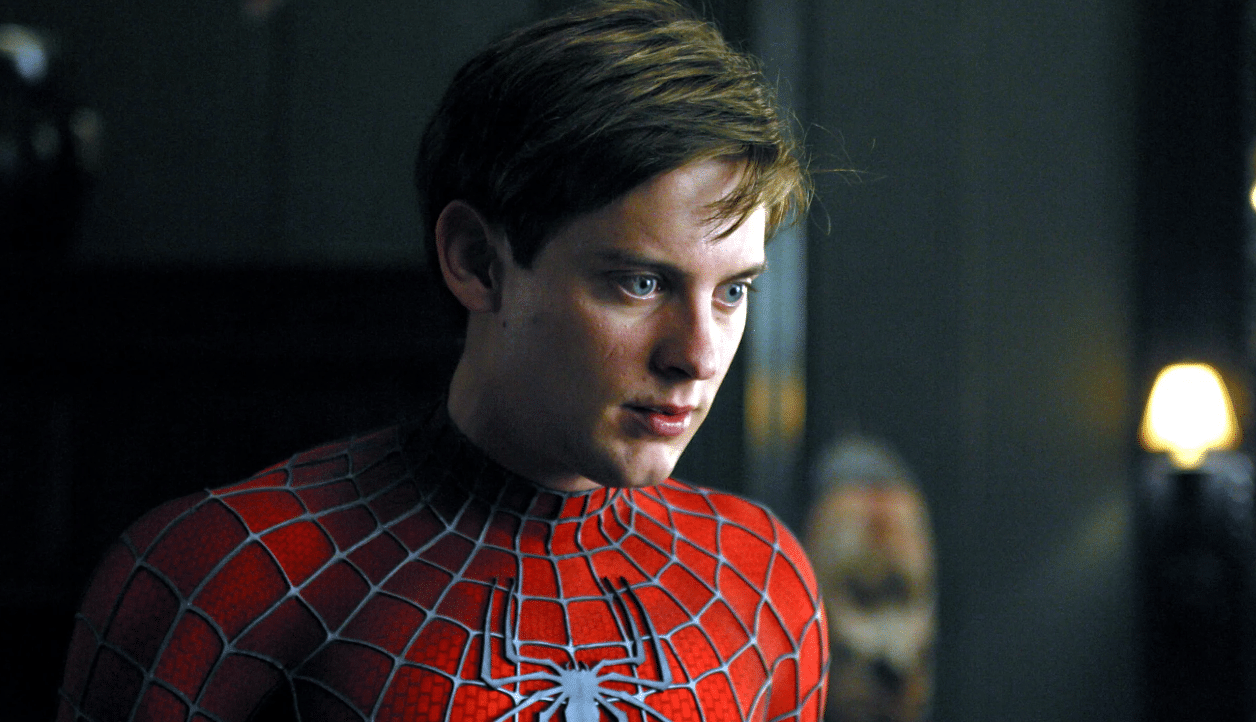
The Trilogy That Changed Everything
When Spider-Man hit theaters in May 2002, it didn’t just shatter box office records—it redefined what a superhero movie could be. Director Sam Raimi, a lifelong comic book nerd, brought heart, horror, and operatic flair to Peter Parker’s origin. Tobey Maguire played Peter with a soft-spoken awkwardness that made him feel like a true underdog. And Willem Dafoe’s Green Goblin? Pure campy menace.
The movie’s massive success ($825 million worldwide) proved superheroes could anchor blockbuster franchises—and it paved the way for the entire modern comic book movie boom.
Spider-Man 2 (2004): A Superhero Masterpiece
This is where Raimi went full Shakespeare. Spider-Man 2 isn’t just one of the best Spider-Man films—it’s one of the best superhero movies ever made. Period. Alfred Molina’s Doctor Octopus is sympathetic, tragic, and unforgettable. The train fight? Still iconic. Peter’s existential crisis—losing his powers, questioning his purpose, trying to live a normal life—hit hard. It was smart, emotional, and visually spectacular.
Critics and fans alike agreed: this was peak Spidey.
Spider-Man 3 (2007): Too Much, Too Fast
Unfortunately, the trilogy didn’t stick the landing. Spider-Man 3 was overloaded with villains (Sandman, New Goblin, and a studio-mandated Venom), too many plotlines, and an infamous emo Peter Parker dance number that instantly became internet legend.
Raimi later admitted he wasn’t happy with how the film turned out—and the planned Spider-Man 4 (which would’ve introduced Vulture and Black Cat) was scrapped after creative clashes with Sony. Just like that, the Maguire era was over.
🕸️ Marc Webb / Andrew Garfield Era (2012–2014)🕸️
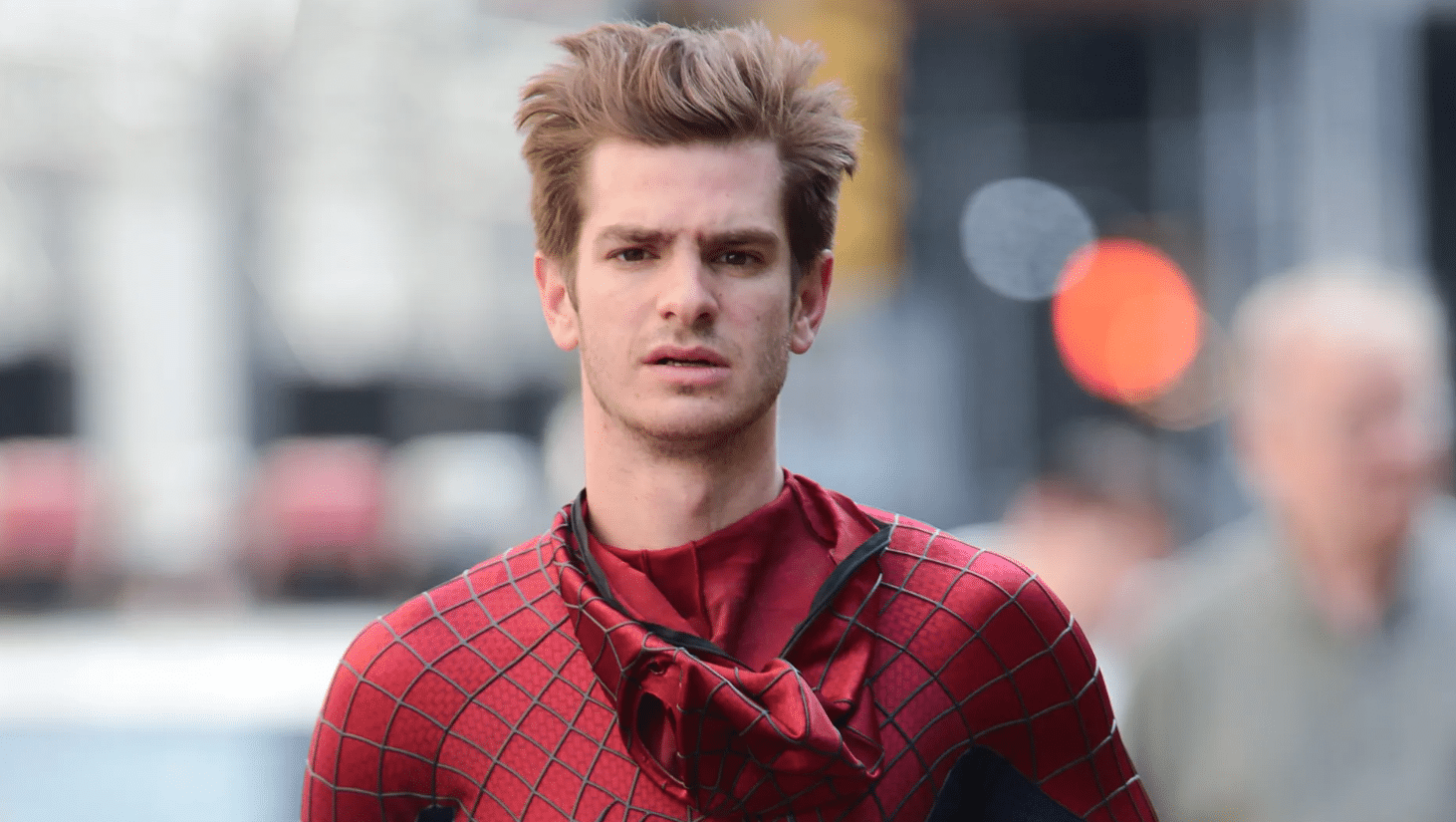
The Reboot With a Broken Heart
Five years after Raimi’s trilogy ended, Sony hit reset with The Amazing Spider-Man. Directed by Marc Webb (500 Days of Summer), the reboot leaned darker, grittier, and more grounded. Andrew Garfield’s Peter Parker was more modern—less nerdy, more edgy—but his chemistry with Emma Stone’s Gwen Stacy was the real highlight. Their relationship felt genuine, and it gave the film real emotional weight.
The Lizard was a serviceable villain, and the origin story was retold with tweaks (hello, mechanical web-shooters), but the movie’s best moments were quieter, not louder.
The Amazing Spider-Man 2 (2014): Ambition Meets Chaos
This one had potential—and problems. The sequel tried to set up a larger universe: teasing the Sinister Six, introducing Harry Osborn’s Green Goblin, and shoehorning in Electro, Rhino, and secret Oscorp experiments. It was messy. Overstuffed. Rushed.
But Emma Stone’s Gwen Stacy shined again—right up until her devastating fall at the end. That clock tower scene mirrored her comic book death, and Garfield’s reaction was raw and gut-wrenching. Say what you will about the movie’s flaws, that scene hit.
Sony’s Fallout and the Leaks Heard Round the World
Behind the scenes, things were getting rocky. Sony’s emails leaked during the infamous 2014 hack, revealing creative tensions, awkward branding plans (remember “Aunt May: Secret Agent”?), and desperation to keep the franchise alive. The Sinister Six spinoff and Amazing Spider-Man 3 were shelved.
So Sony did something unexpected: they struck a deal with Marvel Studios.
🕸️ MCU / Tom Holland Era (2016–present)🕸️
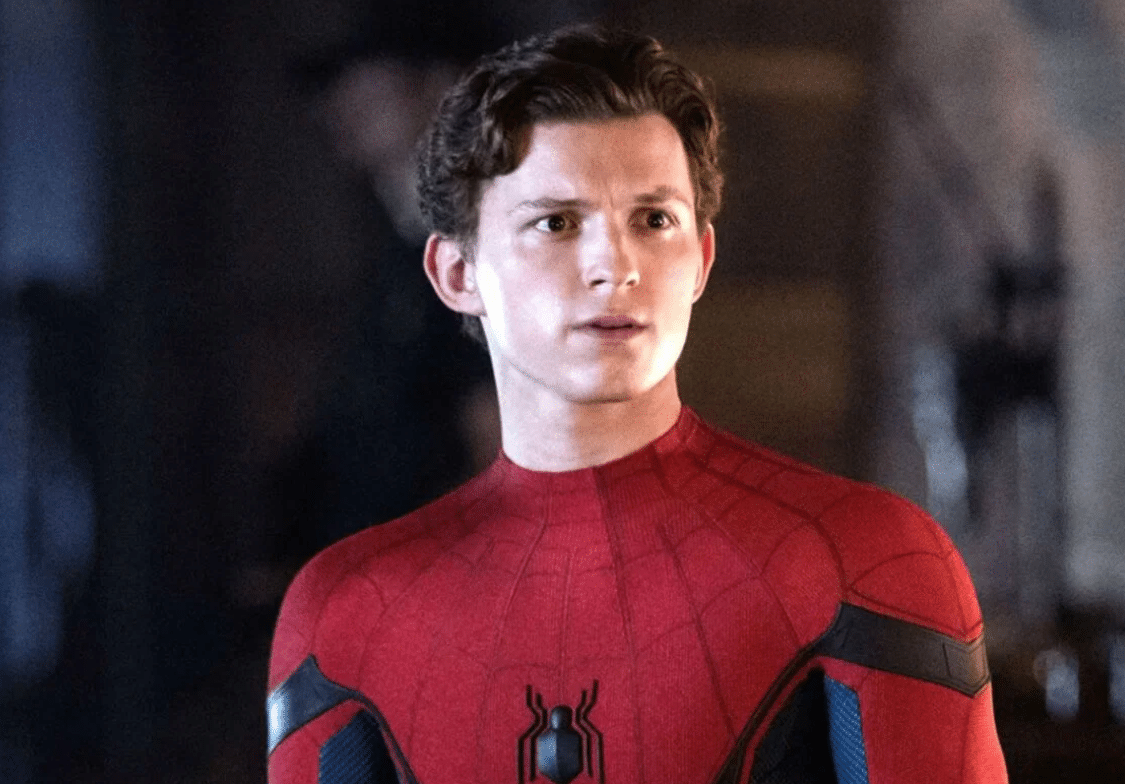
A New Spidey Swings In
Tom Holland made his surprise debut as Spider-Man in Captain America: Civil War (2016), and fans were instantly sold. His Peter was young, funny, dorky, and finally felt like a teenager. Plus, he wasn’t rebooting the origin again. No spider bite. No Uncle Ben death on screen. Just a kid dropped into a world of Avengers, alien invasions, and interdimensional chaos.
Tony Stark took on a mentor role, giving Peter a slick new suit and some high-tech upgrades. Some loved it. Some missed the old-school, DIY Spidey. But there’s no denying Holland brought new life to the character.
Homecoming (2017), Far From Home (2019), and No Way Home (2021)
Homecoming leaned into high school comedy vibes, with Michael Keaton’s Vulture delivering a grounded, menacing performance. Far From Home pushed things global, introducing Jake Gyllenhaal’s Mysterio and some trippy illusions. But No Way Home? That was something else entirely.
Bringing back Tobey Maguire and Andrew Garfield for a multiverse team-up could’ve been a gimmick. Instead, it was pure magic. Fans cheered in theaters as all three Spider-Men cracked jokes, healed each other’s trauma, and faced off against a villain mashup. It became the highest-grossing Spider-Man movie ever and proved that nostalgia, done right, can be a superpower.
What’s Next for Holland’s Spidey?
Rumors are swirling about Spider-Man 4 with a darker tone and a more grounded, post-multiverse Peter. Marvel and Sony have teased a new “college trilogy,” potentially featuring street-level threats, Daredevil cameos, and a stripped-down Spidey—no more Stark tech, just a kid and his homemade suit trying to survive. Whenever it drops, one thing’s clear: Tom Holland isn’t done yet.
🕸️ Spider-Verse Animated Films 🕸️

Into the Spider-Verse (2018): Pure Innovation
This movie didn’t just raise the bar—it demolished it. Into the Spider-Verse introduced the world to Miles Morales in jaw-dropping, glitchy, kinetic animation that felt like a comic book come alive. With a stacked cast (Shameik Moore, Hailee Steinfeld, Jake Johnson, and more), a killer soundtrack, and emotional depth, it became an instant classic.
It won the Oscar for Best Animated Feature—and rightfully so. No other superhero film looked, sounded, or felt like it.
Across the Spider-Verse (2023): Expanding the Web
The sequel somehow upped the ante. Across the Spider-Verse sent Miles hurtling through a kaleidoscope of alternate realities, each with its own art style and Spider-variant. Spider-Man 2099 (voiced by Oscar Isaac) emerged as a complex new antagonist, and Gwen Stacy got a richly emotional arc of her own.
It ended on a cliffhanger, leaving fans desperate for the final chapter. But as far as second acts go, this one delivered on every front—action, heart, visuals, and lore.
Beyond the Spider-Verse (TBD)
Originally set for 2024, the third installment has been delayed, and rightfully so—animation at this level takes time. But whenever it arrives, Beyond the Spider-Verse promises to close out Miles’ journey and (hopefully) reunite the characters fans have grown to love. Expect more spider-people, more multiverse weirdness, and some big emotional swings.
From Raimi’s operatic heroism to Miles Morales’ glitchy grace, Spider-Man movies have redefined the genre again and again. They’ve mirrored their times, reflected their fans, and constantly evolved without losing what makes the character great: a kid, a mask, and the weight of the world on his shoulders.
And as long as there are screens—and stories to tell—Spider-Man will keep swinging.
Web-Slinging Beyond the Page and Screen
Spider-Man might’ve been born in the comics, but let’s be real—he’s way too big for just one medium. Over the years, the web-head has slung his way into video games, action figure aisles, Halloween racks, Broadway stages, and even theme parks. He’s more than a superhero at this point—he’s a brand, a business, and a billion-dollar piece of pop culture.
Let’s take a look at all the places Spider-Man’s been beyond the page—and why he’s still everywhere today.
🕸️Video Games🕸️
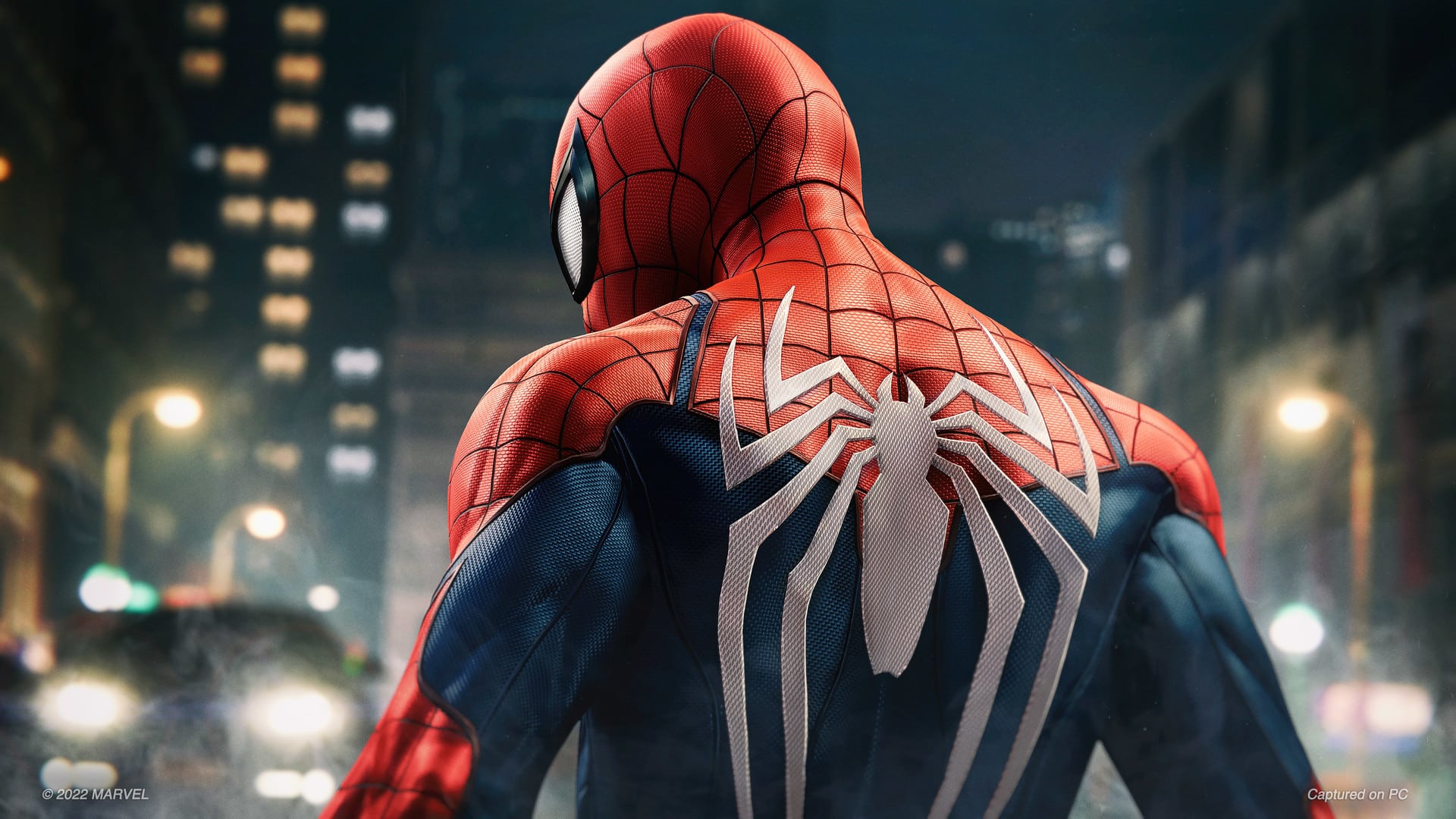
1982: Atari Debut
Spider-Man’s first official video game dropped on the Atari 2600, and yeah—it was clunky. The graphics were primitive, the movement was stiff, and the gameplay was basically just climbing up a building. But in 1982? That was enough. It was actually the first video game to star a Marvel character, which is a fun trivia flex if you’re ever at nerd bar trivia night.
2000: Neversoft’s Spider-Man on PlayStation
Now this was a turning point. Released on the original PlayStation, Neversoft’s Spider-Man gave players their first real taste of web-slinging in 3D. It had narration from Stan Lee, tons of Marvel cameos (Black Cat! Venom! Daredevil!), and a perfect blend of stealth, action, and comic-book flair. For many fans, this was their gateway into Spidey’s world—and it still holds up surprisingly well.
2004: Spider-Man 2 and Open-World Glory
Based on the Sam Raimi sequel, Spider-Man 2 on PS2/GameCube/Xbox was the first game to nail what it felt like to be Spider-Man. The web-swinging was physics-based, the city was fully open, and you could just… swing around New York for hours. Honestly? A generation of players did exactly that. It set the standard for every Spidey game that followed.
2018–2023: Insomniac’s Spider-Verse
Enter: Marvel’s Spider-Man on PS4. This wasn’t just a great superhero game—it was one of the best games of the decade, period. With slick combat, heartfelt storytelling, and the most satisfying web-swinging ever coded, Insomniac’s Spidey delivered. Then came Miles Morales in 2020, a shorter but powerful follow-up with winter-in-Harlem vibes and a killer soundtrack. And in 2023? Spider-Man 2 blew the doors off with dual protagonists, Venom, and next-gen polish. If you want to feel like Spider-Man, this is it.
Spidey in the Fight Game World
Let’s not forget his side hustle: throwing hands in fighting games. Spider-Man’s been a fan favorite in Marvel vs. Capcom since the ’90s—zipping across the screen, bouncing off walls, and unleashing supers like “Maximum Spider.” He’s also popped up in titles like Shattered Dimensions, Edge of Time, and the LEGO Marvel series, each with their own spin on his powers and personality.
🕸️Toys and Merchandising🕸️
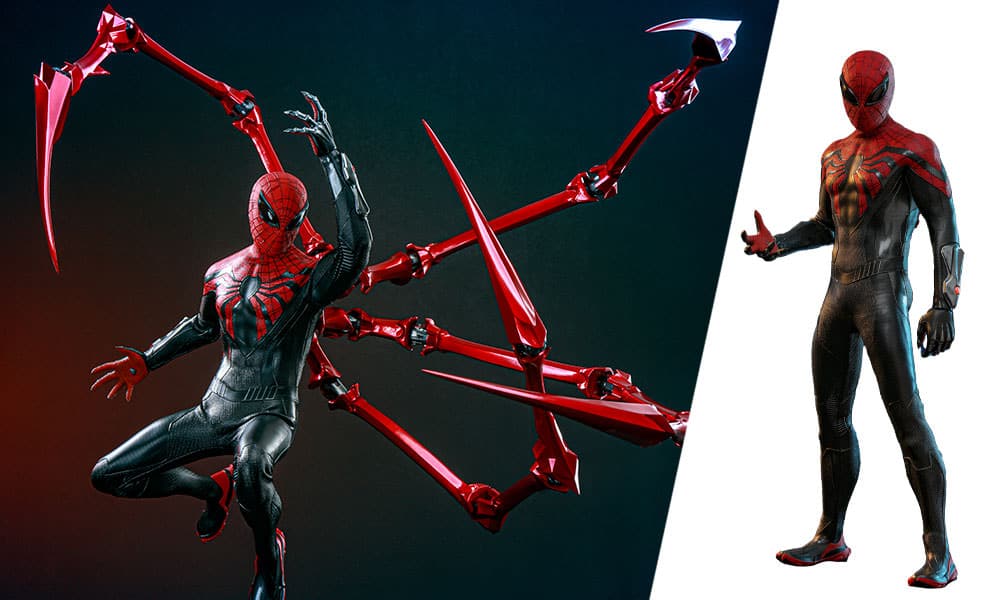
Spider-Man isn’t just one of the most recognizable superheroes—he’s also one of the most marketable. The guy moves merch like nobody else.
1970s: Mego Dolls
The Mego Spider-Man action figure was one of the earliest and most iconic. With cloth suits, removable boots, and those charmingly awkward proportions, it became a staple of every ’70s toy chest. If you’ve ever seen one at a flea market, you know the vibe.
1990s: Toy Biz Takeover
This is when things exploded. The ’90s Toy Biz line—launched alongside the Spider-Man: The Animated Series—had everything: wall-crawling Spideys, deep-cut villains, weird web-themed vehicles, and more variant costumes than you could count. Armored Spider-Man? Check. Arctic Spider-Man? Absolutely. It was toy aisle chaos, and we loved it.
Modern Merch Madness
These days, Spidey merch is everywhere—from ultra-detailed Hot Toys figures for collectors to Hasbro’s Marvel Legends line. And then there’s LEGO Spider-Man, who’s starred in dozens of sets, video games, and animated shorts. There’s even a LEGO Daily Bugle set with over 3,700 pieces (and half of Spidey’s rogues’ gallery). It’s absurd. And glorious.
Fun Fact: Spider-Man Halloween costumes outsell every other superhero, year after year.
It’s true. Not Batman. Not Iron Man. Not even Elsa. Spider-Man reigns supreme every October—and probably always will.
🕸️Broadway and Theme Parks🕸️
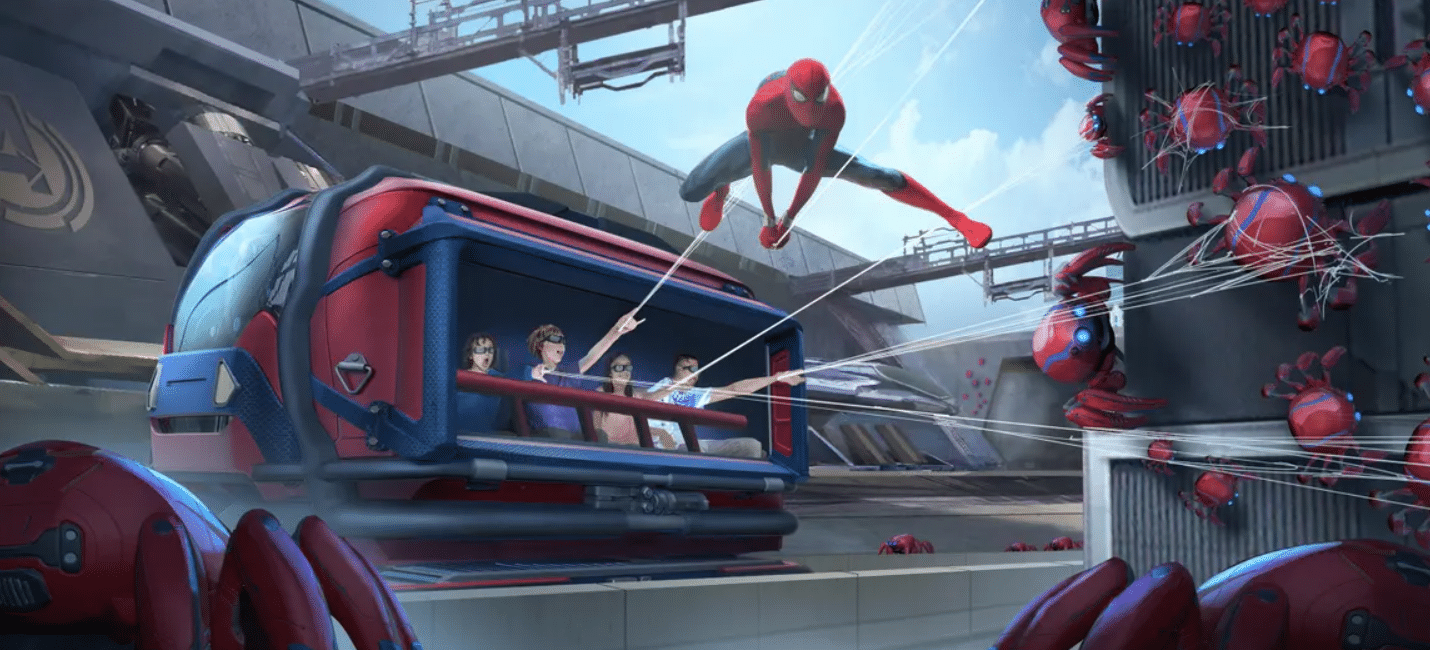
Spider-Man: Turn Off the Dark – The Musical That (Barely) Survived
It was supposed to be a game-changer. A rock opera co-written by Bono and The Edge of U2. A $75 million Broadway extravaganza with aerial stunts, elaborate sets, and a full-blown Green Goblin musical number. Instead? It became one of the most infamous productions in theater history.
Spider-Man: Turn Off the Dark had delays, rewrites, technical failures, and multiple stunt performers injured during rehearsals. Critics panned it. Fans were confused. But somehow, it ran for over 1,000 performances—and turned into a cult curiosity. If nothing else, it proved that Spider-Man really can do anything… even musical theater.
Universal Studios Florida – The Amazing Adventures of Spider-Man
This 3D motion-sim ride debuted in 1999 and still slaps. You hop in a “news van,” don 3D glasses, and race through a full-blown supervillain battle with explosions, drops, and one-liners. It’s been upgraded over the years, but the core ride is a fan favorite and still draws crowds today.
Disneyland – Avengers Campus: Web Slingers Ride
In 2021, Disney opened Avengers Campus in California—and gave Spider-Man his own ride. Web Slingers: A Spider-Man Adventure uses motion-tracking tech to let riders physically web-shoot at rogue Spider-Bots. It’s family-friendly, frantic, and kind of a workout. Plus, Tom Holland reprised his MCU role for the ride’s intro video, so it’s canon-ish!
TL;DR? If there’s a format, screen, or toy shelf out there—Spider-Man’s on it. And he’s not just showing up. He’s dominating. From pixelated swings on the Atari to Broadway curtains and LEGO fire escapes, the wall-crawler has done it all. And something tells us he’s just getting started.
Beyond Peter Parker: The Many Spider-Heroes
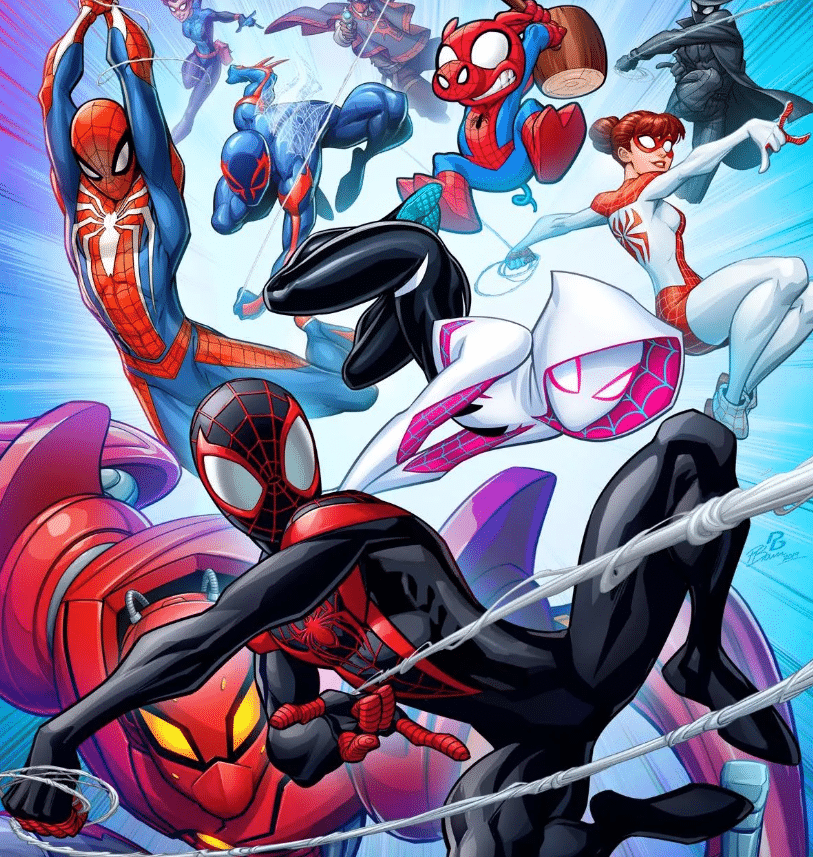
Spider-Man’s greatest trick? Proving that anyone can wear the mask. Over the years, Marvel has built out a full-blown Spider-Verse—an ever-expanding web of alternate universes where spider-heroes take wildly different forms. Some are heartfelt. Some are hilarious. Some wield guitars, mechs, or mystical powers. But they all carry that same core truth: with great power comes great responsibility.
Here’s a breakdown of the biggest names (and wildest web-heads) from across the multiverse.
🕸️Miles Morales🕸️
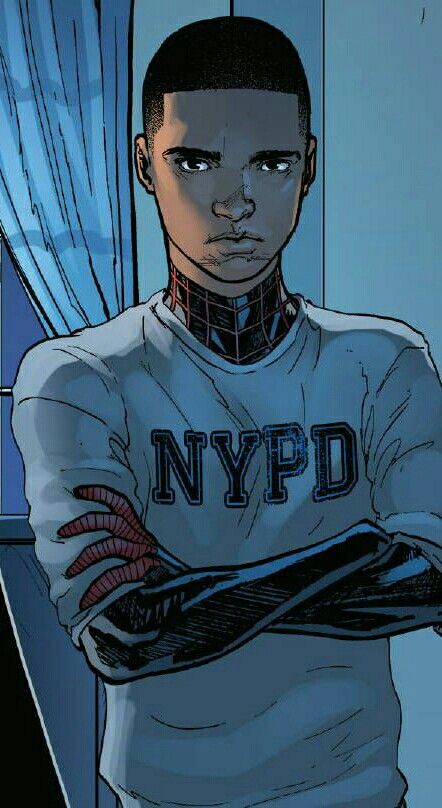
First swinging onto the scene in Ultimate Fallout #4 (2011), Miles Morales stepped into the Spider-Man role in Marvel’s Ultimate Universe after Peter Parker was killed saving the city. Created by writer Brian Michael Bendis and artist Sara Pichelli, Miles was a game-changer—bringing Afro-Latino representation to the forefront in a way superhero comics hadn’t done before.
He’s younger, less experienced, and just trying to figure it all out, which makes him incredibly relatable. But he’s also got his own unique edge—bio-electric venom blasts, camouflage invisibility, and a totally different home life from Peter. His mom’s a nurse, his dad’s a cop, and he’s constantly balancing expectations, identity, and what it really means to live up to a legacy.
Thanks to Into the Spider-Verse, Miles became a household name, inspiring millions of new fans and proving Spider-Man isn’t defined by a single face. He’s not the next Spider-Man—he’s his own Spider-Man.
🕸️Spider-Gwen (Ghost-Spider)🕸️
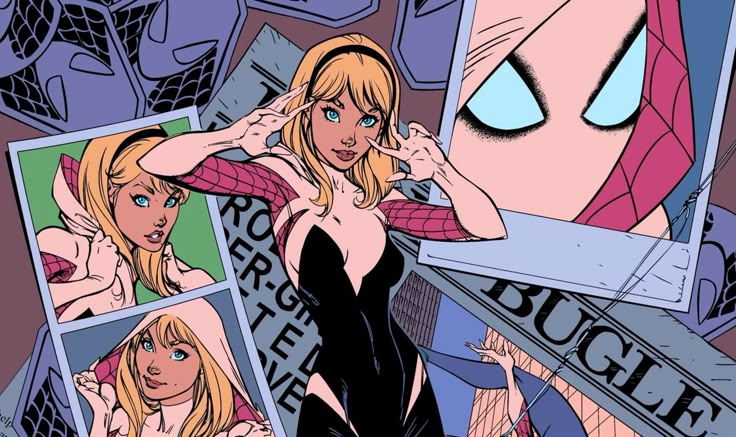
Gwen Stacy has always been one of Peter Parker’s most tragic storylines—but in Earth-65, she got a second chance, and a hell of a redemption arc. Bitten by the radioactive spider instead of Peter, Gwen became her universe’s Spider-Woman. Peter, meanwhile, tried to become a hero through science—and tragically became her first real villain.
Gwen’s story is laced with guilt, grief, and empowerment. She’s part punk rocker, part vigilante, and all heart. Her suit—white, pink, and black with a hoodie—became an instant cosplay classic, and her solo runs have consistently explored themes of forgiveness, friendship, and identity.
As Ghost-Spider, she jumps between dimensions, often teaming up with other spider-heroes and carving out her own lane far from Peter’s shadow. In the Spider-Verse films, she’s a standout—balancing combat skills, leadership, and emotional depth. She’s not just a what-if—she’s a must-have in the Spider-family.
🕸️Spider-Man 2099 (Miguel O’Hara)🕸️
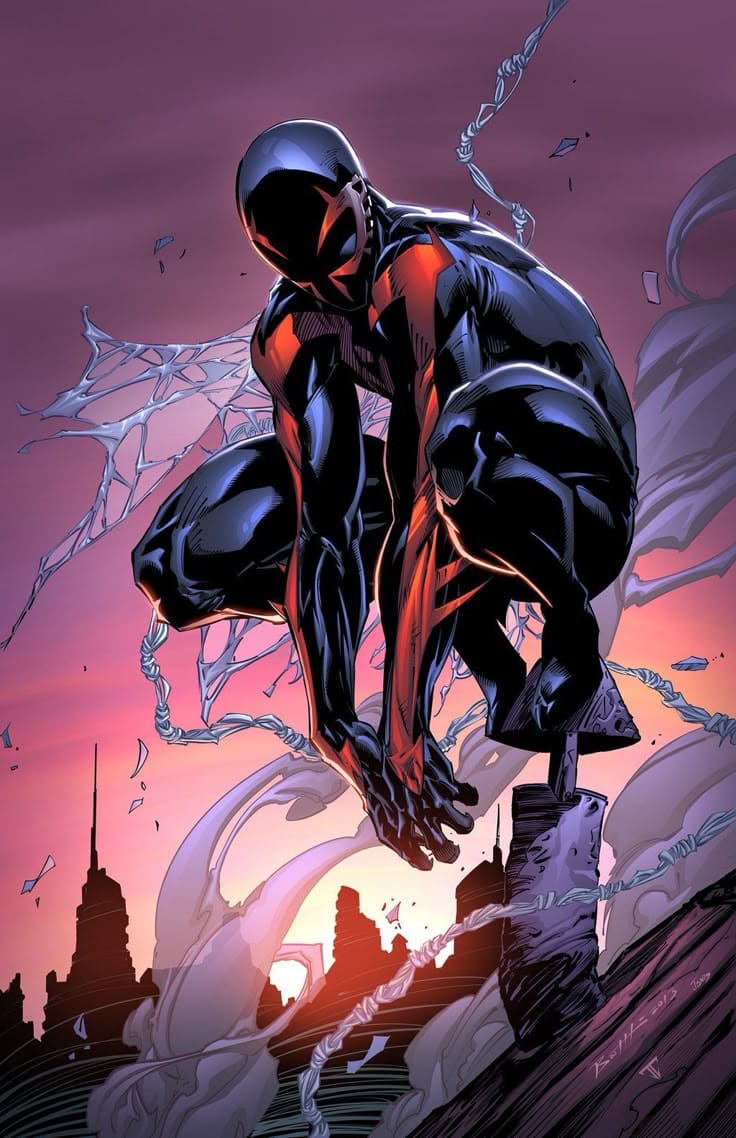
Long before cyberpunk was trendy again, Spider-Man 2099 dropped us into the neon-drenched future of Nueva York. Miguel O’Hara is a genius geneticist working for a corrupt mega-corporation, Alchemax. When he tries to escape their grip, a sabotage attempt leaves him with spider powers encoded into his DNA.
Unlike Peter, Miguel’s powers include talons, fangs, enhanced vision, and no web-shooters—he glides on a cape of light fibers and scales walls like a predator. He’s serious, short-tempered, and constantly toeing the line between corporate prisoner and reluctant revolutionary.
Miguel was one of Marvel’s most successful ‘90s alt-heroes, and Across the Spider-Verse turned him into a full-blown multiverse enforcer—equal parts antagonist, tragic figure, and badass. He doesn’t joke around, and he definitely doesn’t dance. But when the Spider-Verse needs structure and sacrifice, Miguel steps in.
🕸️Spider-Ham (Peter Porker)🕸️
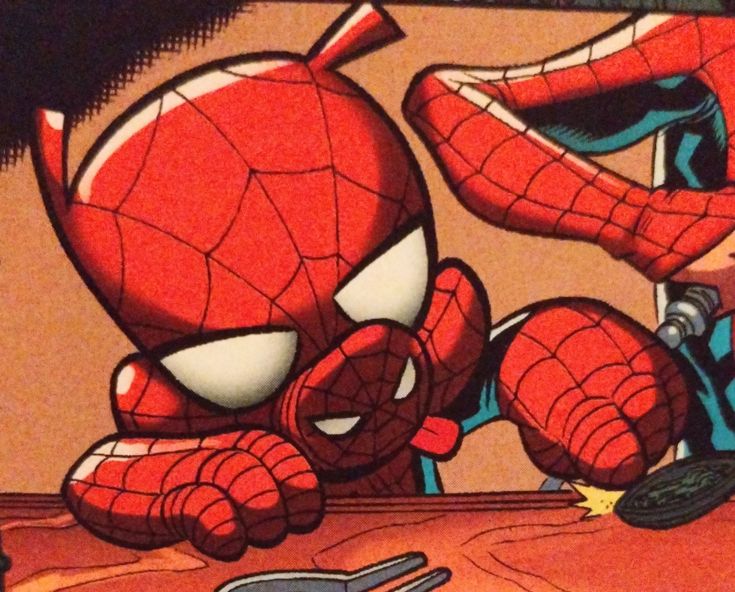
Yes, he’s a talking pig. Yes, his name is Peter Porker. And yes, he absolutely rules.
Spider-Ham debuted in Marvel Tails #1 (1983) as a Looney Tunes-style parody of Spider-Man, born when a radioactive pig bit a spider… who then turned into a pig. (No, we’re not making this up.) He lives in a cartoon animal world filled with characters like Captain Americat and Ducktor Doom.
He’s ridiculous in the best way—comedic, fourth-wall breaking, and slapstick-savvy. But here’s the twist: he’s also weirdly competent. In Into the Spider-Verse, he plays comic relief but still packs a punch when it counts. He even has his own line of mini-comics, toys, and shorts. He’s the pork you didn’t know you needed.
🕸️Peni Parker🕸️
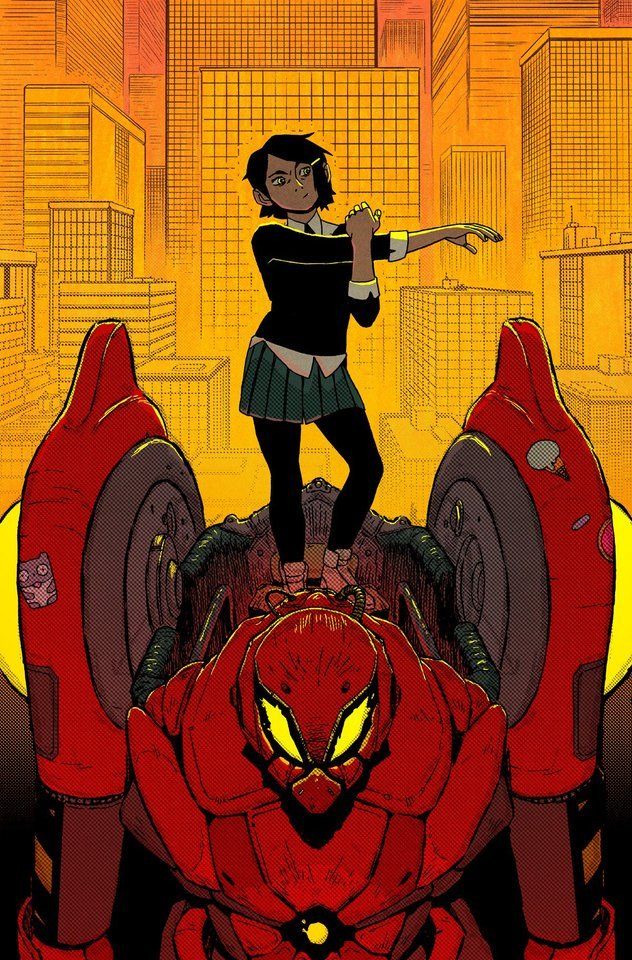
Peni isn’t your average spider-hero. Created in Edge of Spider-Verse #5 (2014), she lives in a futuristic reality where she co-pilots a sentient spider-mech called SP//dr. Her bond with the suit isn’t just emotional—it’s psychic, maintained through a spider that lives inside the machine. (Creepy, but cool.)
She’s a blend of anime tropes and Western storytelling: soft-spoken but emotionally complex, gentle but determined. She’s also just a kid, which makes her battles feel heavier—because she’s constantly up against world-ending threats with the pressure of legacy on her shoulders.
Visually, she’s stunning. In the Spider-Verse films, her animation style is pulled straight from anime, with expressive, kinetic motion that separates her from the rest of the cast. She’s a symbol of how Spider-Man stories can stretch genre and format while still hitting those core beats of responsibility and courage.
🕸️Spider-Noir🕸️
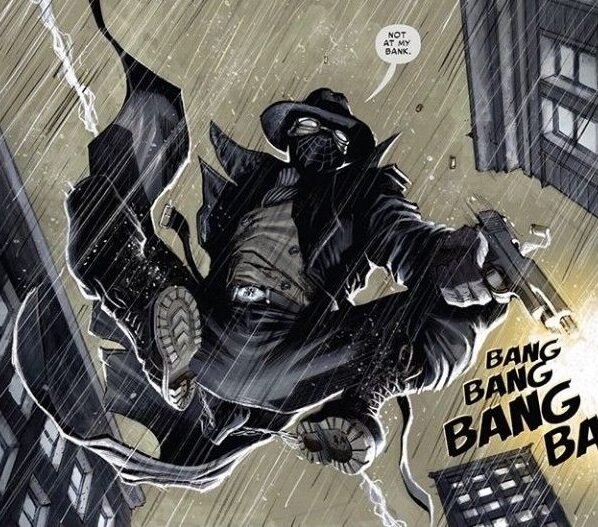
Hailing from Earth-90214, Spider-Noir is a trenchcoat-wearing, hard-boiled version of Peter Parker fighting crime in 1930s New York. He’s moody, black-and-white, and walks around quoting pulp novels like they’re gospel. Introduced in Spider-Man: Noir #1 (2009), he was part of Marvel’s “Noir” line of reimagined heroes—and quickly became a fan favorite.
In this world, Peter gets his powers from a spider idol tied to ancient mythology. He doesn’t just punch thugs—he investigates, broods, and broils in existential dread. Into the Spider-Verse turned him into meme gold, thanks to Nicolas Cage’s perfectly unhinged voice performance and obsession with Rubik’s Cubes.
He’s the voiceover monologue that never ends—and somehow, that’s exactly what makes him work.
🕸️Spider-UK (Billy Braddock)🕸️
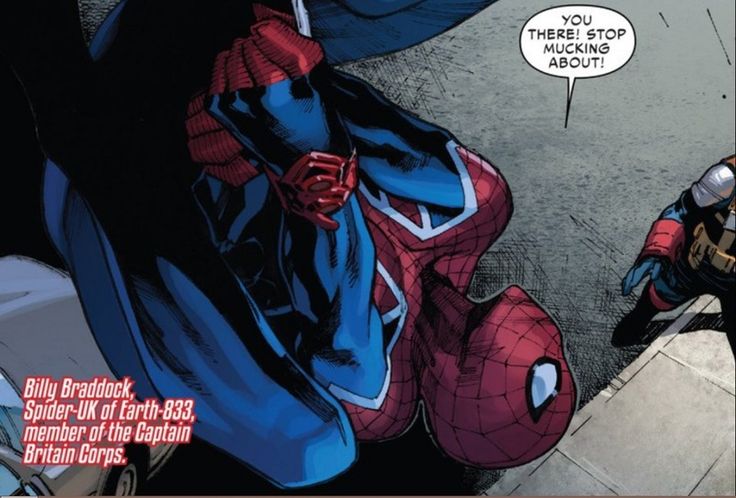
Billy Braddock, also known as Spider-UK, first appeared in Edge of Spider-Verse #2 as the official spider-themed representative of the Captain Britain Corps. He’s kind of like the MI6 version of Spider-Man—stoic, honorable, and built for multiverse missions.
His suit blends Spider-Man’s signature look with British iconography—red, blue, and white with a Union Jack pattern. He’s a frontline soldier in multiverse battles, and a key player in Spider-Verse and Spider-Geddon events, often rallying the troops and coordinating cross-dimensional missions.
He may not have the flashiest personality, but when the multiverse needs saving, Spider-UK shows up first.
🕸️Spider-Punk (Hobart “Hobie” Brown)🕸️
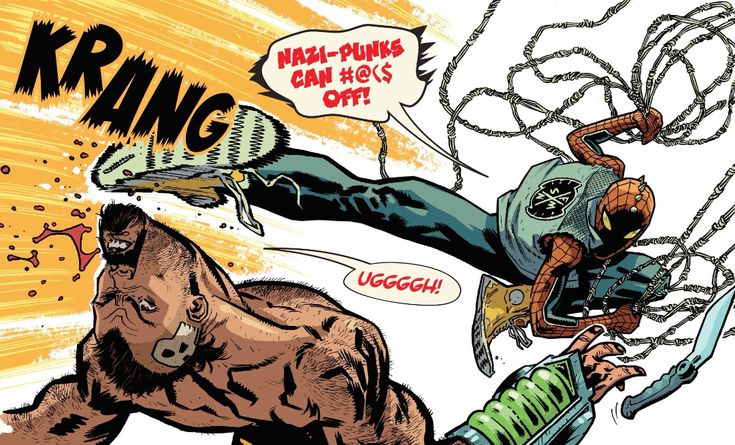
Spider-Punk doesn’t do authority—he smashes it with a guitar.
Hobie Brown comes from Earth-138, where President Norman Osborn runs a fascist regime. After gaining spider powers, Hobie becomes a punk-rock rebel who fights tyranny with anti-establishment fire and killer riffs. His look? Mohawk, denim vest, spikes, boots—and a guitar that doubles as a web-blasting, villain-bashing weapon of rage.
Originally a one-off variant in Amazing Spider-Man #10 (2015), Hobie exploded in popularity—especially after Across the Spider-Verse, where Daniel Kaluuya’s voice performance turned him into a scene-stealing icon. He’s rebellious, brilliant, chaotic, and cooler than everyone in the room. Basically? Spider-Man with a bass drop.
🕸️Pavitr Prabhakar (Spider-Man India)🕸️
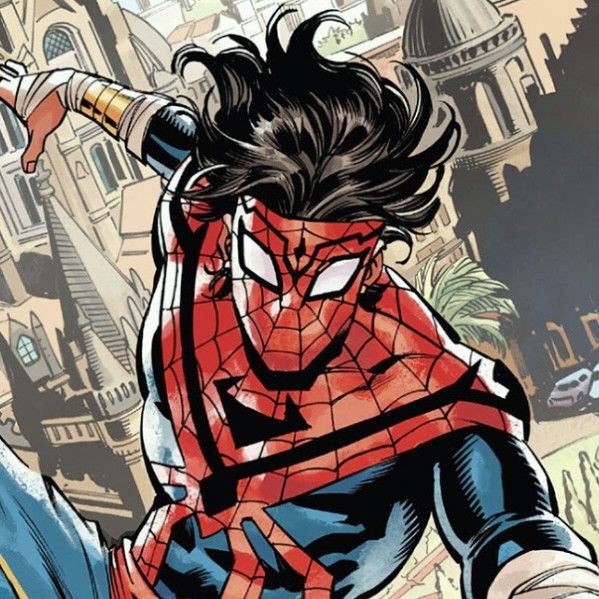
Debuting in Spider-Man: India #1 (2004), Pavitr Prabhakar is the Indian reimagining of Peter Parker. Set in Mumbai, his origin mirrors Peter’s: a humble student raised by loving relatives, bitten by a mystical spider, given powers, and forced to learn the harsh lesson of responsibility through personal loss.
But his world is shaped by Indian culture, mythology, and spirituality. Instead of the Green Goblin, he faces a rakshasa-possessed version of Norman Osborn. Instead of swinging between skyscrapers, he moves through crowded cityscapes and ancient temples.
Across the Spider-Verse gave him a fresh redesign and vibrant personality—equal parts charm, confidence, and killer quips. Also? Best hair in the multiverse. Easily.
🕸️Madame Web (Cassandra Webb)🕸️
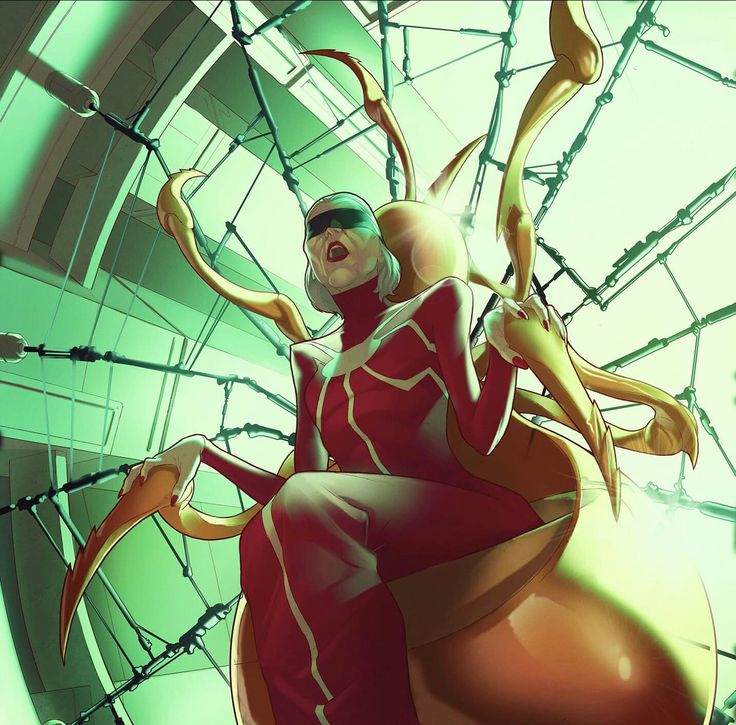
Cassandra Webb is the mystical backbone of the Spider-Verse. Blind and paralyzed, she’s hooked to a life-support system that looks like a spiderweb—and her psychic abilities let her see through time, fate, and multiple realities.
Introduced in Amazing Spider-Man #210 (1980), she’s not a fighter, but she’s essential. She appears when the web is unraveling—offering cryptic advice, guidance, or sometimes just vague riddles that make everything way more complicated.
🕸️Julia Carpenter🕸️
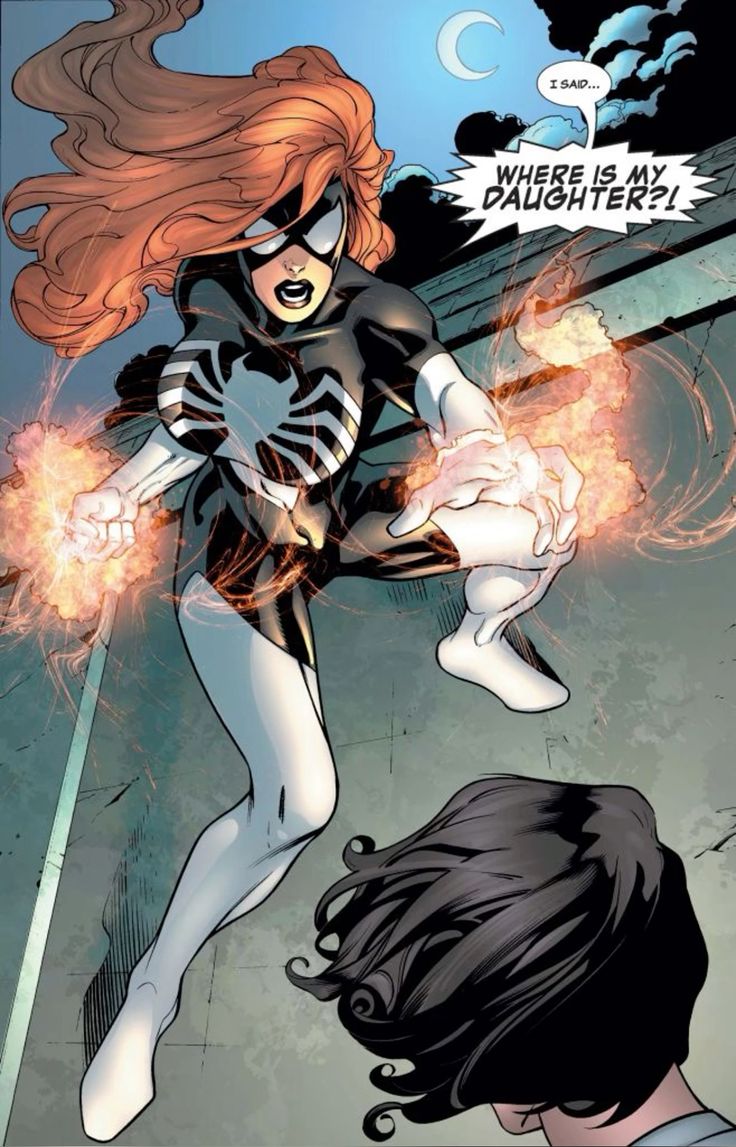
Originally introduced as the second Spider-Woman in Secret Wars #6 (1984), Julia rocked the black suit look before Venom made it edgy. She had enhanced agility, psionic webbing, and a slightly different power set—but always felt like part of the family.
Eventually, Julia inherited Cassandra Webb’s powers and mantle, becoming the new Madame Web. As the more action-ready version of the role, she serves as a bridge between prophecy and battle—often stepping in to help guide younger heroes through multiversal madness. She’s equal parts fighter and mystic, with one foot in the web and one in the field.
🕸️May “Mayday” Parker (Spider-Girl)🕸️
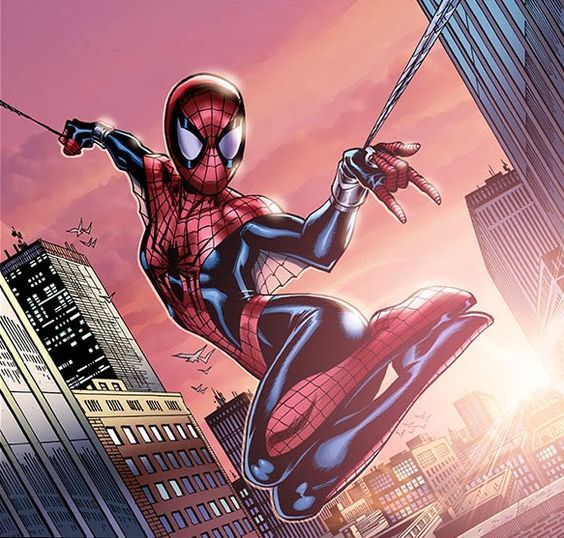
Mayday Parker is the daughter of Peter and Mary Jane from an alternate future where Peter retired after losing a leg in battle. She took up the mask in What If? #105 (1998), and fans loved her so much she got her own series—Spider-Girl—which ran for over 100 issues.
May inherited her dad’s powers and sense of humor, but carved out her own path. Her adventures often blend teen drama with superhero responsibility, and her stories laid the groundwork for the whole “next generation” vibe that characters like Miles and Gwen would later build on.
She’s clever, scrappy, and knows what it means to live in someone’s shadow—while still stepping into the spotlight.
🕸️Kaine Parker🕸️
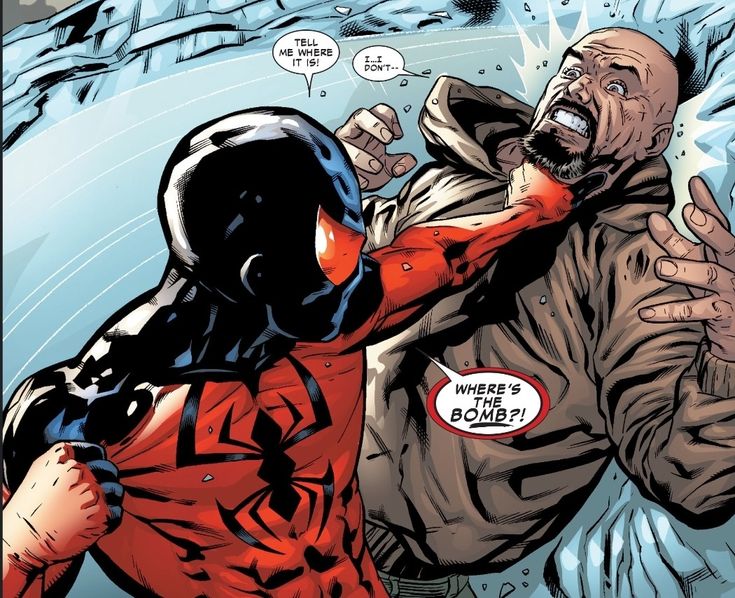
The black sheep of the clone family, Kaine was the first successful clone of Peter Parker—but “successful” is generous. His DNA was unstable, his face distorted, and his rage uncontrollable. Introduced during the Clone Saga in the ’90s, Kaine began as a violent, borderline-unhinged villain with a deep grudge against Ben Reilly and a twisted obsession with protecting Peter and Mary Jane.
But over time, Kaine changed. After years in the shadows, he got a shot at redemption. In 2011’s Scarlet Spider solo series, Kaine moved to Houston, donned a new red-and-black suit, and tried to be a different kind of hero—the kind who punches first, questions later, and hates himself the whole time.
Unlike Peter, Kaine doesn’t pull punches—literally. He has enhanced strength, organic stingers, the ability to melt through walls, and a brutal, no-nonsense approach to justice. He’s less “friendly neighborhood” and more “don’t make me come back here.” But that’s what makes him compelling. He’s not trying to live up to Peter’s legacy—he’s trying to outrun his own.
🕸️Spider-Boy (Bailey Briggs)🕸️
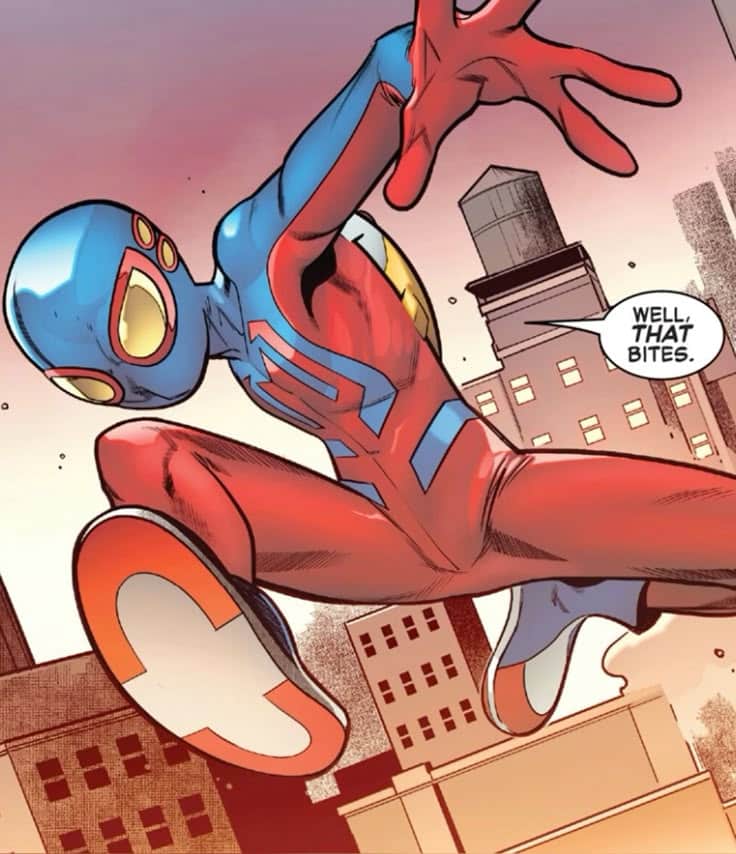
The new kid on the block, Bailey Briggs—aka Spider-Boy—burst into Marvel continuity during Dan Slott’s 2022–2023 Spider-Man run in a multiverse-shifting twist. Retconned as Peter Parker’s long-lost sidekick (yes, really), Bailey was “erased” from everyone’s memory due to a cosmic-level continuity wipe—and now, he’s fighting to remind the world he ever existed.
Bailey’s still shrouded in mystery, but what we do know is that he’s younger than Peter, scrappy, and totally Gen Z. He sports a red-and-blue costume, a mop of wild hair, and a cocky attitude that sits somewhere between Robin and Miles Morales. He’s impulsive, emotional, and just trying to prove he’s not a knockoff.
Too new to fully define, but Spider-Boy’s got big breakout potential—especially if Marvel leans into his outsider status and lost-legacy angst.
🕸️Anya Corazon (Araña / Spider-Girl)🕸️
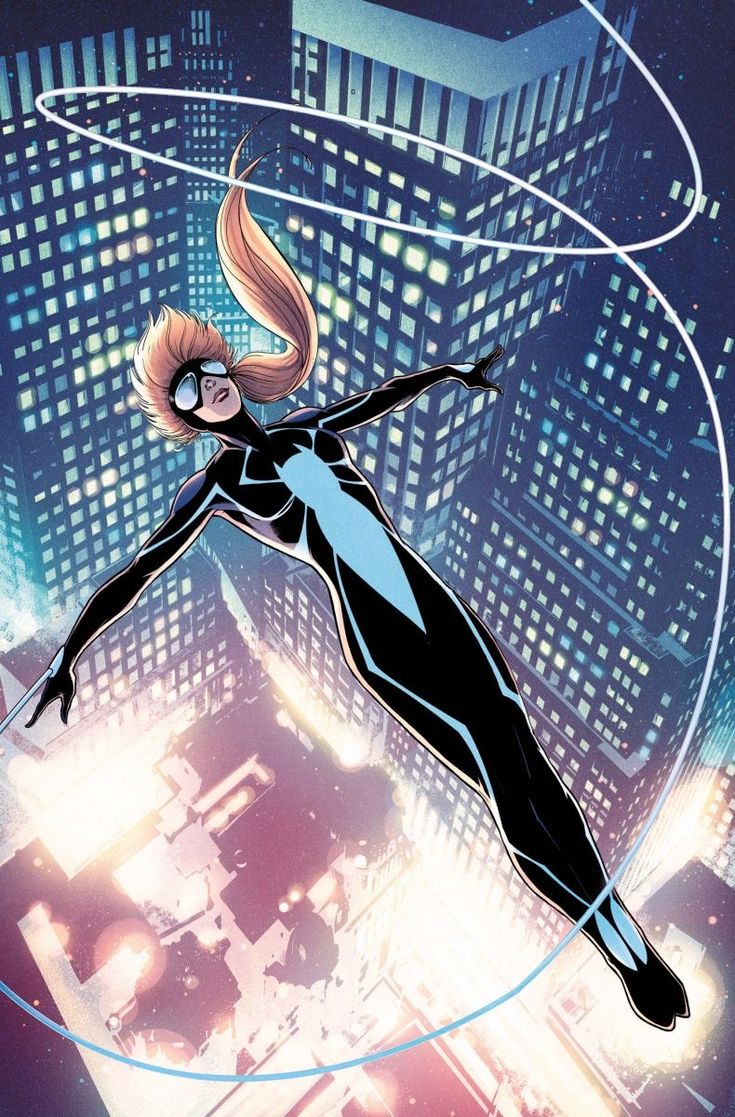
First introduced in Amazing Fantasy #1 (2004), Anya Corazon is a Brooklyn-born Puerto Rican/Mexican-American teenager who didn’t get her powers from a radioactive spider—but from ancient magic tied to a secret warrior society known as The Spider Society. It’s a whole different mythos—and it gave Anya enhanced strength, agility, and a mystical exoskeleton that sprouts when she’s in danger.
Originally going by Araña, Anya was Marvel’s attempt to create a new, modern heroine with a fresh cultural lens—and over time, she’s stepped into the Spider-Girl mantle as well. She’s not just another Spidey—she’s got her own history, her own powers, and her own approach to heroism.
Anya has teamed up with everyone from Ms. Marvel and Miles Morales to the Young Avengers and Champions. She’s funny, fearless, and fiercely loyal—and her bilingual, streetwise voice gives her a unique place in the Spider-family.
She might not always be front and center, but Anya’s become a steady presence in both comics and animated shows—and she’s long overdue for a breakout moment on the big screen.
🕸️Lady Spider (Maybelle Reilly)🕸️

Hailing from Earth-803, Maybelle Reilly is what you get when you cross Spider-Man with Sherlock Holmes and Iron Man. A brilliant inventor in a steampunk 19th-century New York, she was first introduced in the Spider-Verse event as Lady Spider—a corset-wearing, gear-powered vigilante who built her own mechanical spider-limbs to fight crime.
Unlike most Spider-heroes, Maybelle doesn’t have actual powers. She was never bitten. But she’s fierce, fast-thinking, and doesn’t flinch when dropped into a multiversal war alongside symbiotes, time-travelers, and kaiju-sized spider-gods.
She’s been underused since her debut, but she’s a fan favorite in cosplay circles and one of the most inventive spins on the Spider-mythos out there. If there’s a Spider-Verse sequel with more screen time for the deep cuts, Maybelle deserves her moment.
🕸️Spider-Ma’am (Aunt May Parker)🕸️
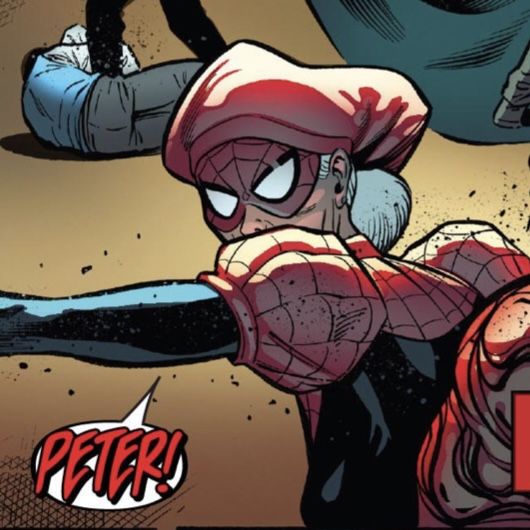
You know her as the sweet, worry-prone aunt who bakes wheatcakes and dotes on Peter. But in Earth-3123? May Parker is the one who got bitten by the radioactive spider—and became the crime-fighting, cookie-baking, web-slinging Spider-Ma’am.
It’s hilarious on the surface—but the beauty of Spider-Ma’am is that it actually works. May uses her powers to fight villains, protect her neighborhood, and still make it home in time to feed Peter and Uncle Ben. Her costume is a mix of practicality and mom-chic: sensible shoes, half-apron, and web-cartridges hidden in her oven mitts (probably).
Originally introduced in What If? #23 (1990), Spider-Ma’am has since shown up in Spider-Verse cameos, toy lines, and all-ages books. She might be a gag—but she’s also kind of a role model.
She reminds us that being Spider-Man isn’t about age, gender, or aesthetics. It’s about heart. And May has plenty of that.
Why Spider-Man Still Matters
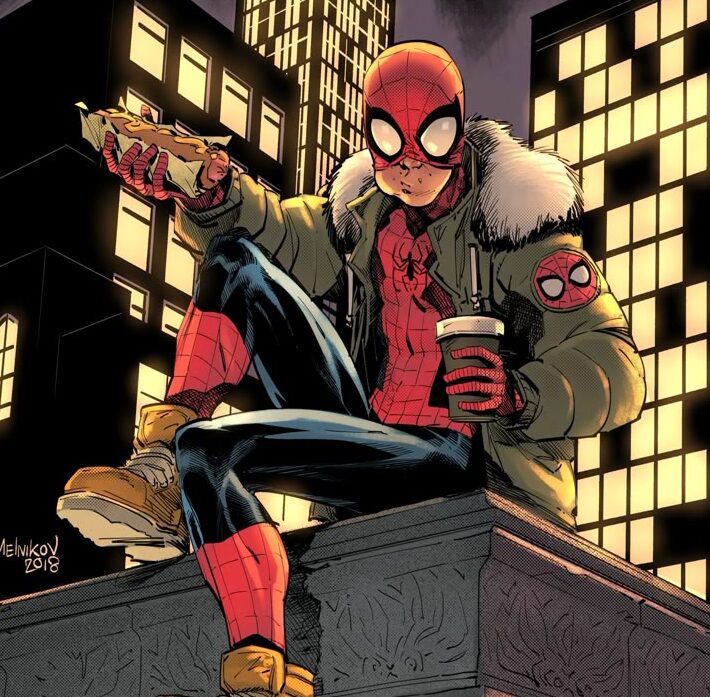
There’s a reason Spider-Man has outlasted fads, trends, and even the rise of a thousand other superheroes. He’s not just Marvel’s mascot—he’s its heartbeat. Across comics, screens, and timelines, Spider-Man keeps showing up because he reflects something universal: the struggle to do the right thing when everything’s going wrong.
🕸️ Power and Responsibility🕸️
It’s the line everyone knows—“With great power comes great responsibility.” But it’s not just a catchphrase. It’s a mission statement. Spider-Man doesn’t fight because he’s the strongest or because he wants the spotlight. He fights because he feels like he has to. Because he didn’t once—and someone he loved died.
That guilt. That purpose. That quiet, relentless need to make things better—that’s what makes Spidey timeless.
🕸️ Relatability Is His Superpower🕸️
Peter Parker worries about rent, deadlines, dating, and disappointing the people he loves. He’s brilliant but broke. Brave but anxious. A superhero who still has to finish his homework, pick up groceries, or explain why he was late again.
That everyday struggle? That’s why readers see themselves in him—whether they’re 13 or 35. Whether they’re reading Amazing Fantasy #15 or watching Across the Spider-Verse on their phone. Spider-Man has always been the most human of heroes.
🕸️ Representation That Grows With the World🕸️
What started as a skinny white kid from Queens has grown into a full-blown Spider-Verse:
-
Miles Morales brings Afro-Latino culture and a modern voice.
-
Gwen Stacy gives girls a fierce, relatable Spider-hero with punk-rock edge.
-
Miguel O’Hara represents a futuristic, Latino vision of Spider-Man with a hard edge and a scientist’s brain.
Every generation finds its own Spider-Man—and every version tells us something new about who gets to be a hero.
🕸️ Marvel’s Survival Icon🕸️
Spider-Man didn’t just help build Marvel—he helped save it. Time and again, when the company was on the ropes, it was Spidey who pulled it back. In the ’60s, he was Marvel’s breakout star. In the ’90s, his comics outsold everyone. In the 2000s, he carried the cinematic reboot. And today? His movies, games, and multiverse continue to break records and set standards.
He’s not just a character. He’s the lifeline.
🕸️ Still Swinging in the Modern World🕸️
In 2025, Spider-Man memes are everywhere. His movies trend on TikTok. His GIFs live in group chats. There’s a Spidey suit for every mood: classic, emo, armored, punk, glitchy, anime, you name it. The Spider-Verse tapped into multiversal storytelling before it was cool, and now it’s a pop-culture juggernaut.
He evolves. He adapts. He sticks. And he’s still the most beloved web-slinger on the planet.
Because in the end, Spider-Man isn’t perfect. He messes up. He loses. He doubts.
But he keeps getting back up—and that’s what makes him a hero worth rooting for.

